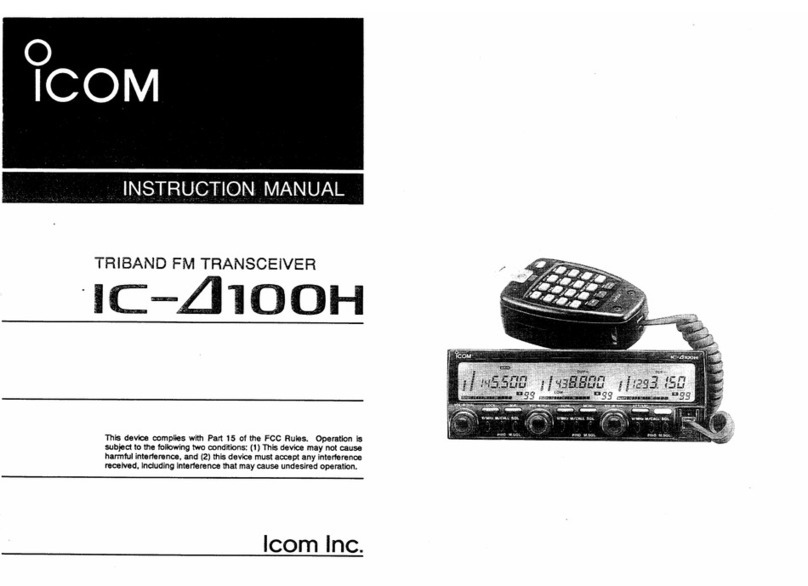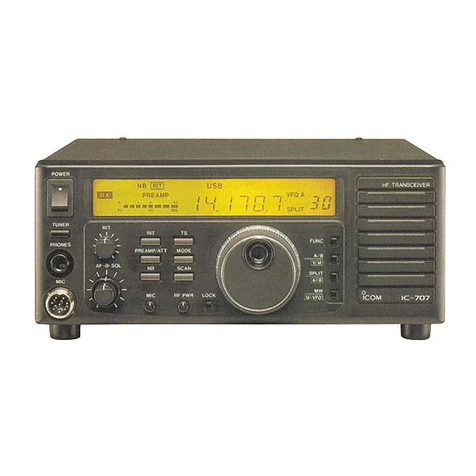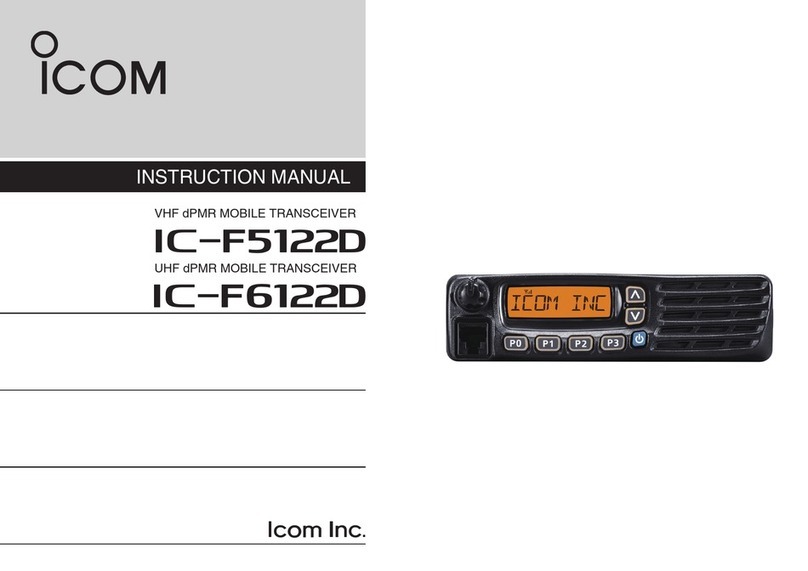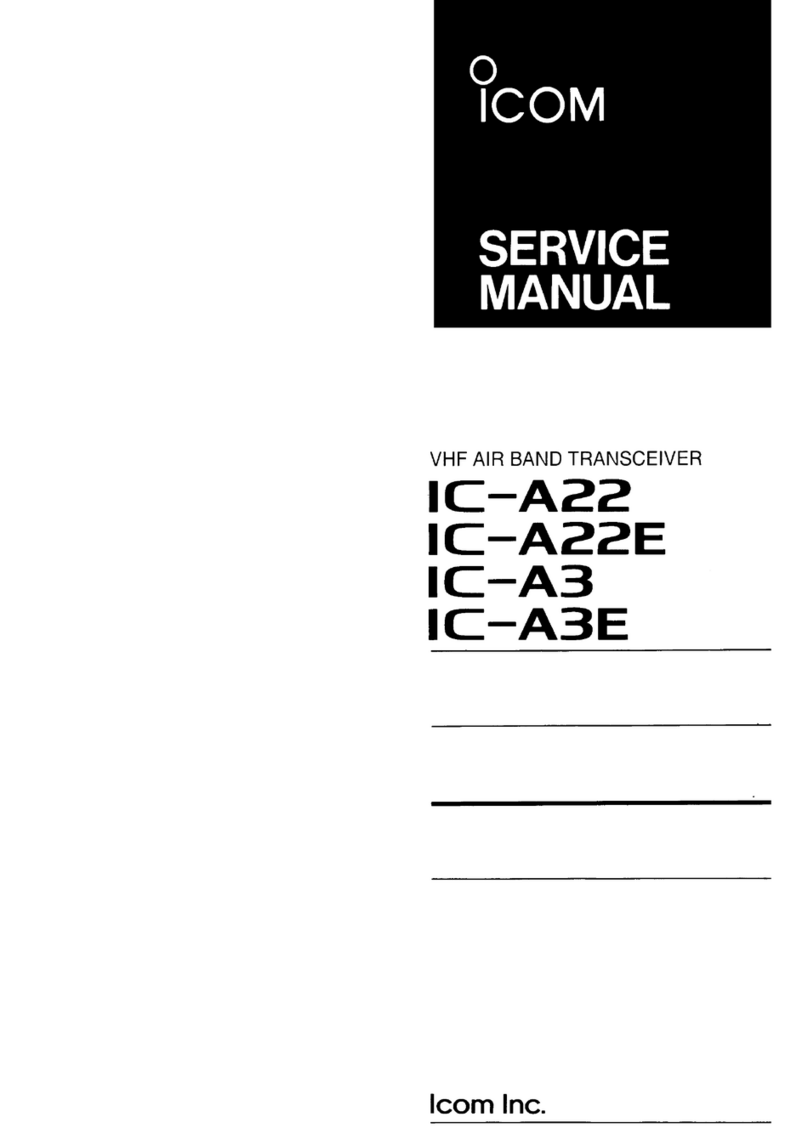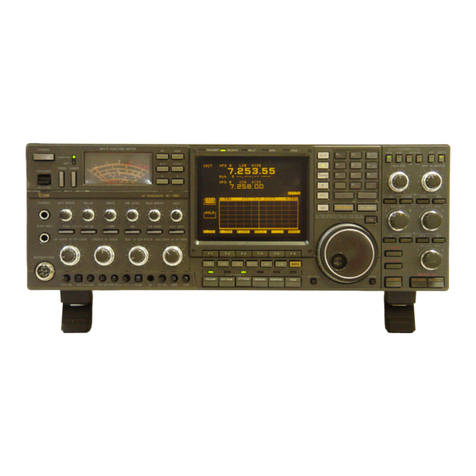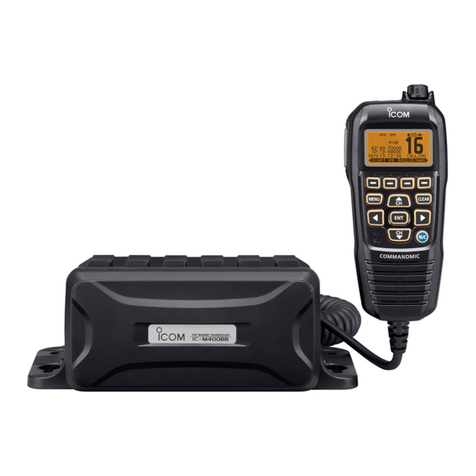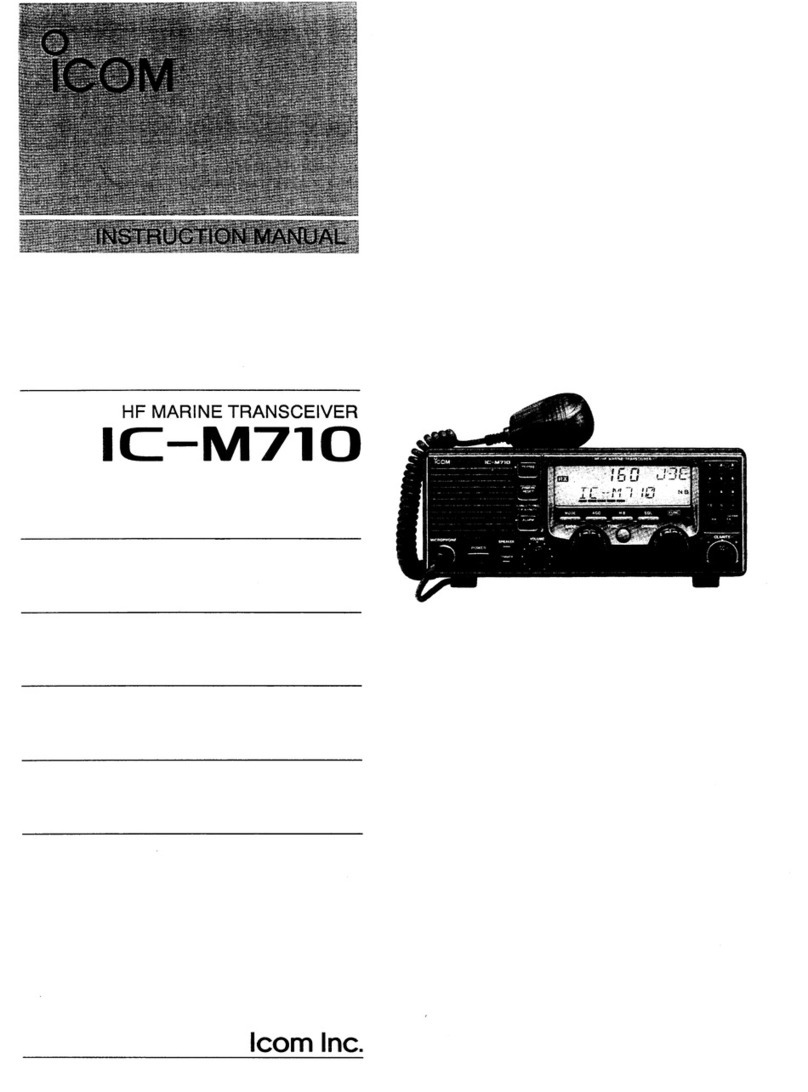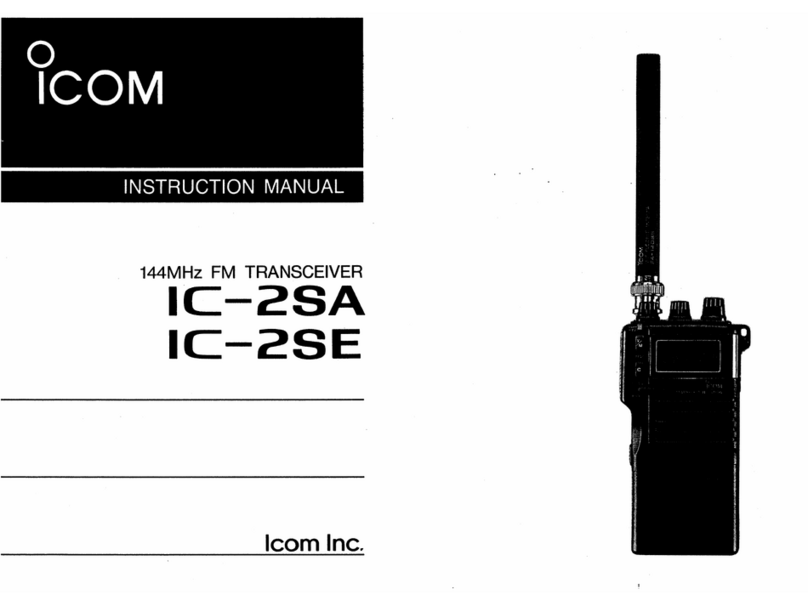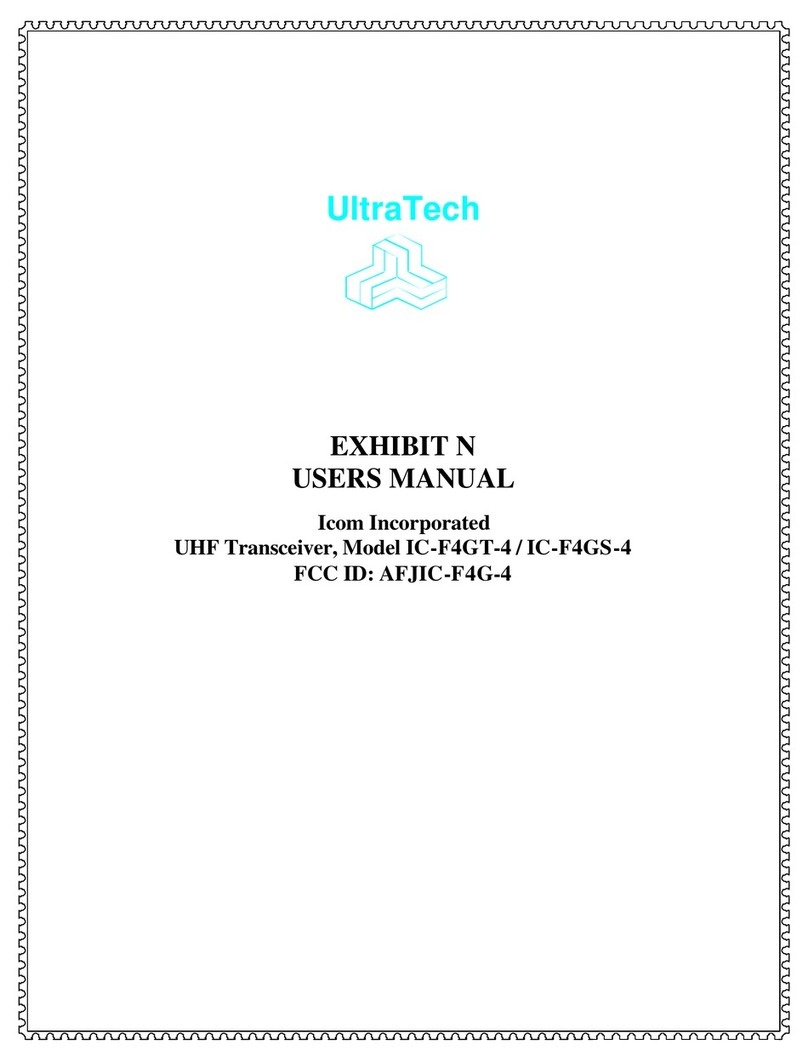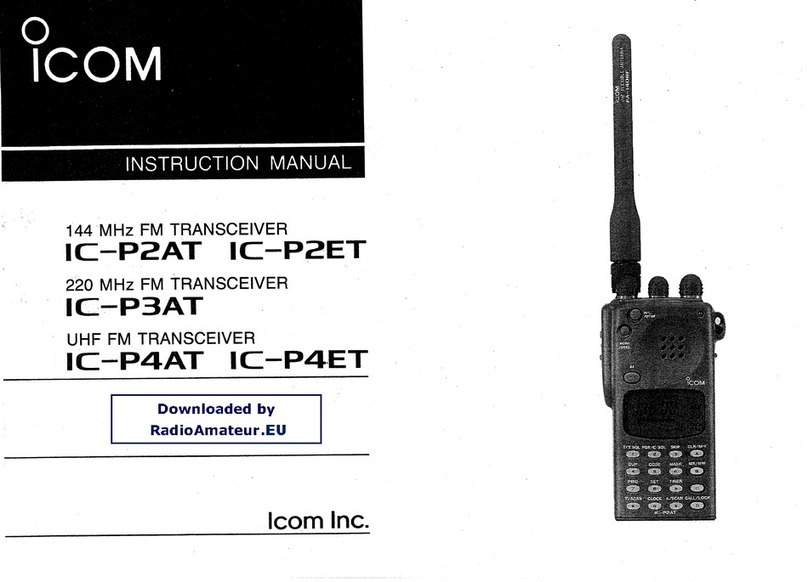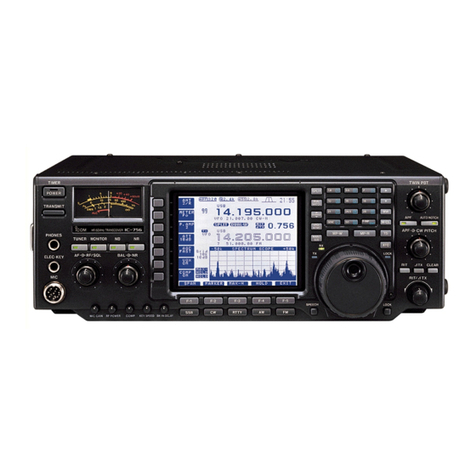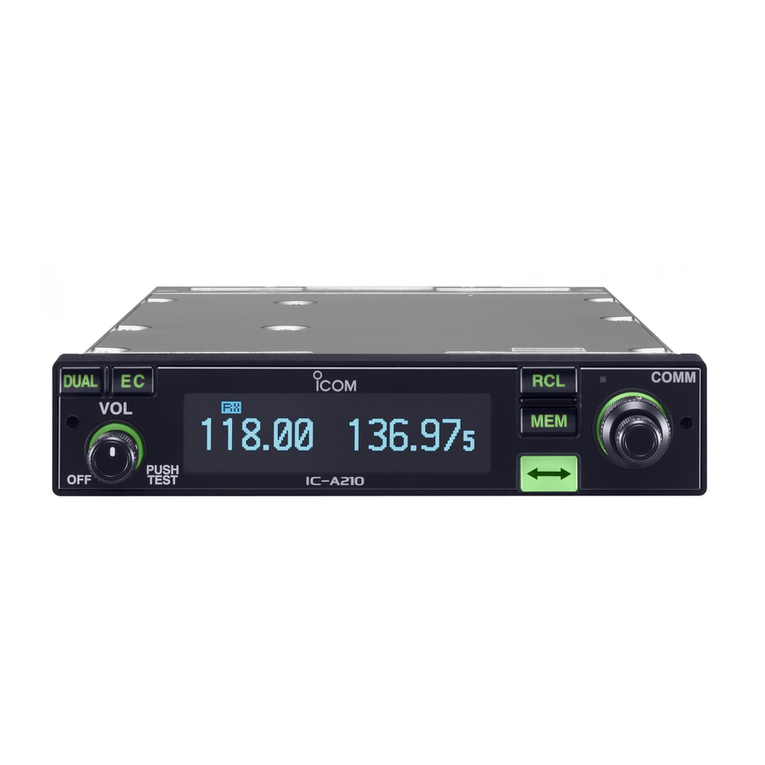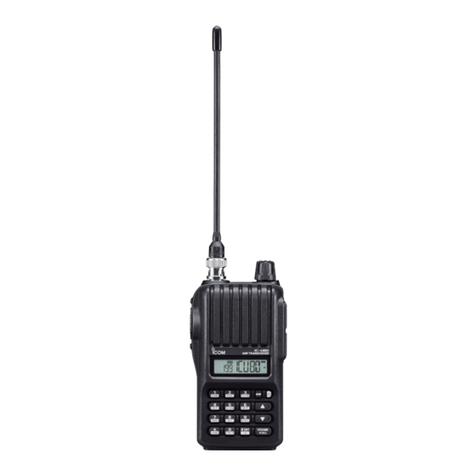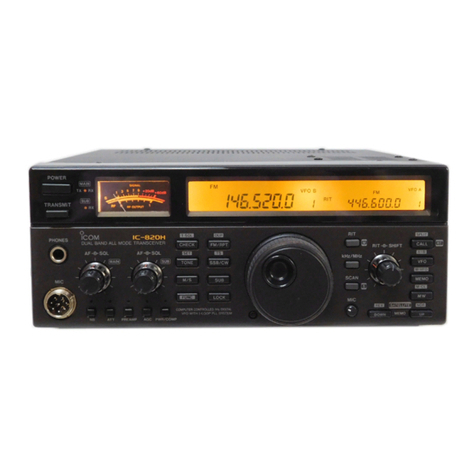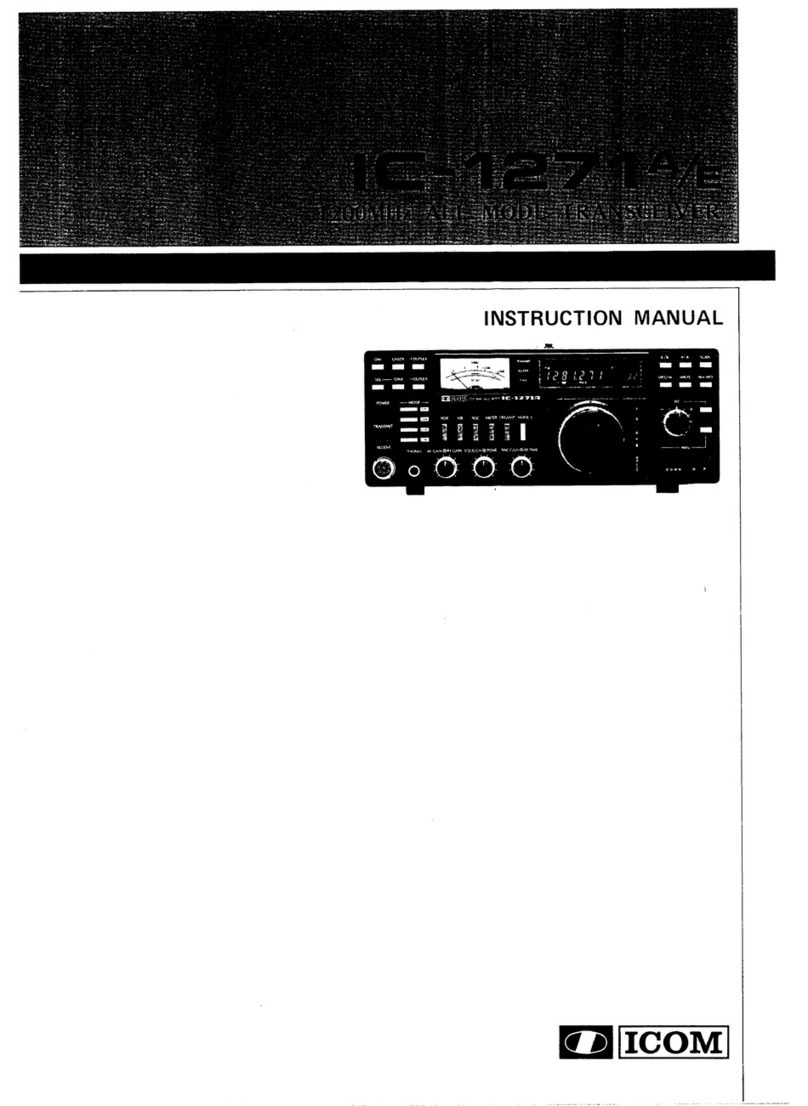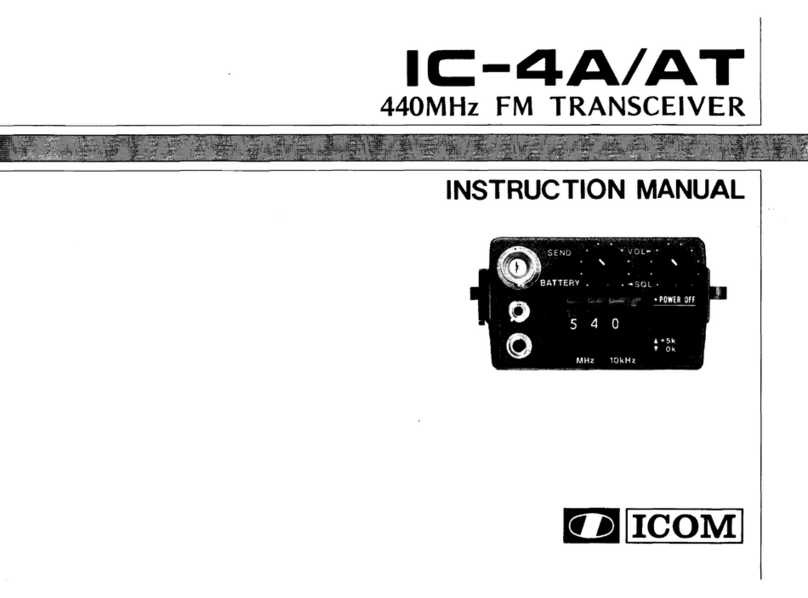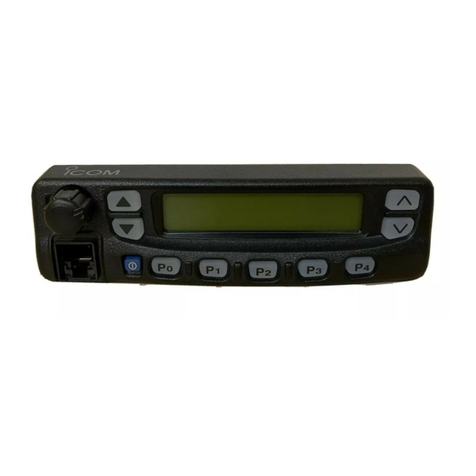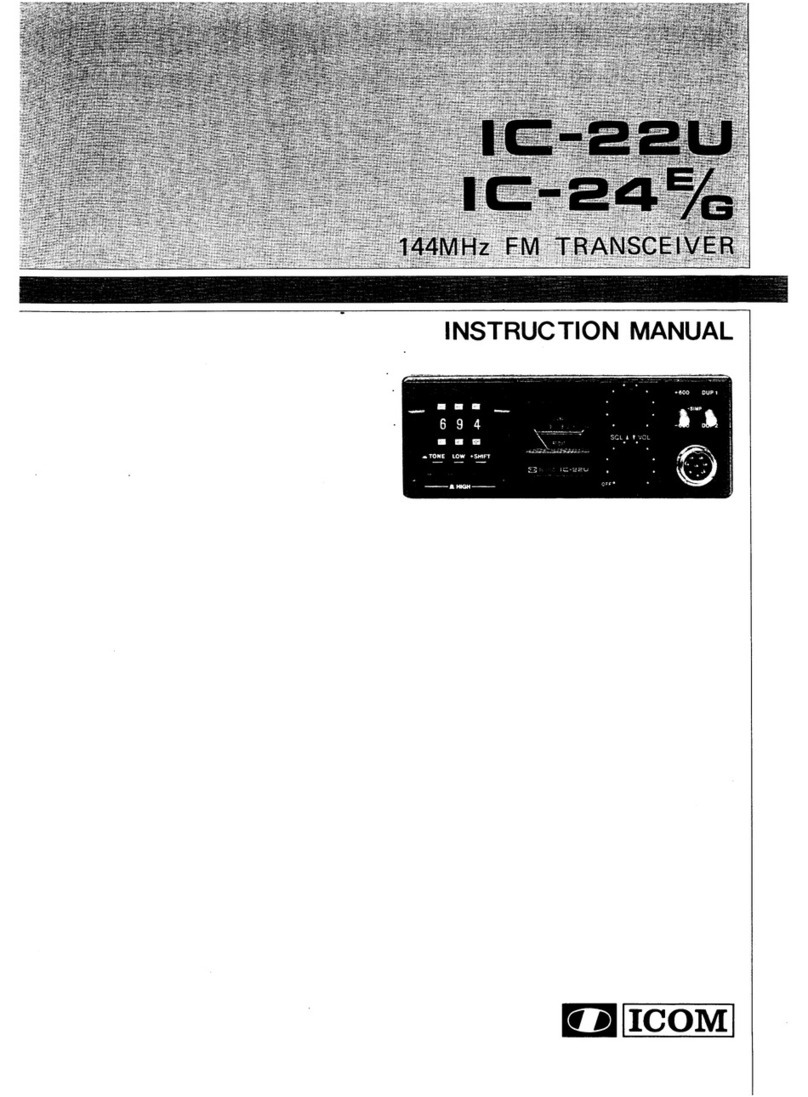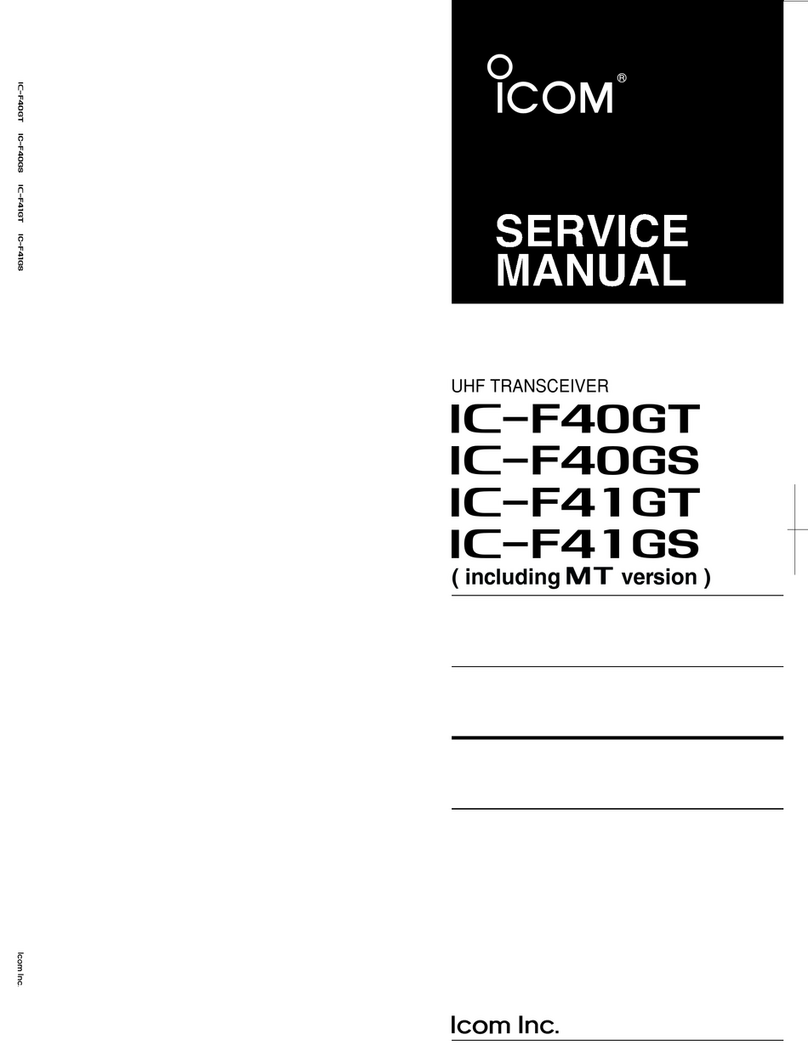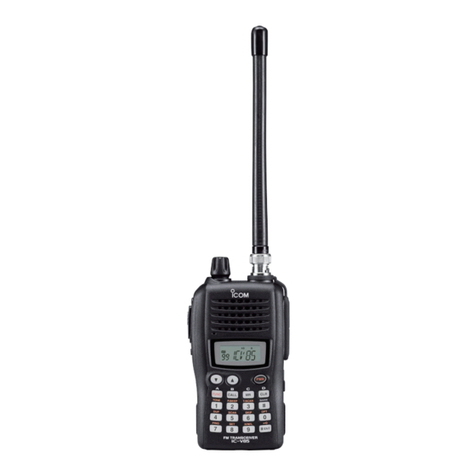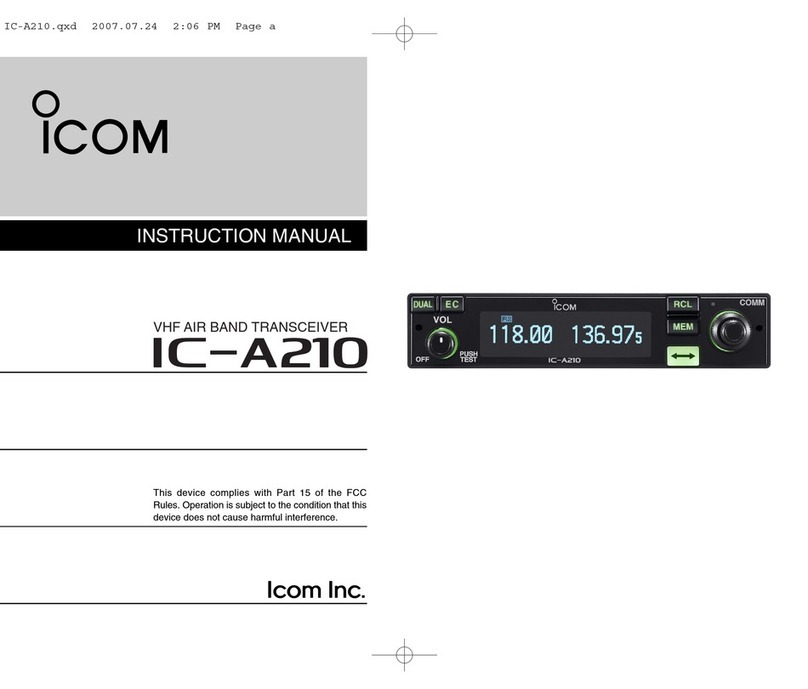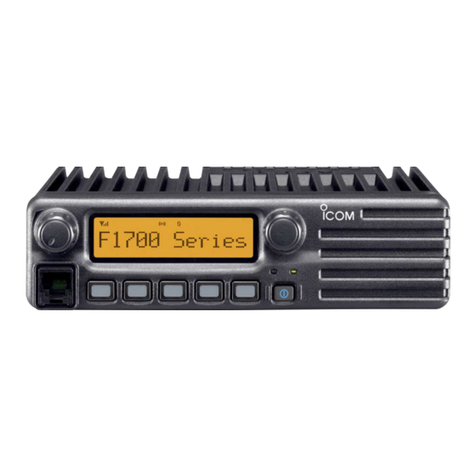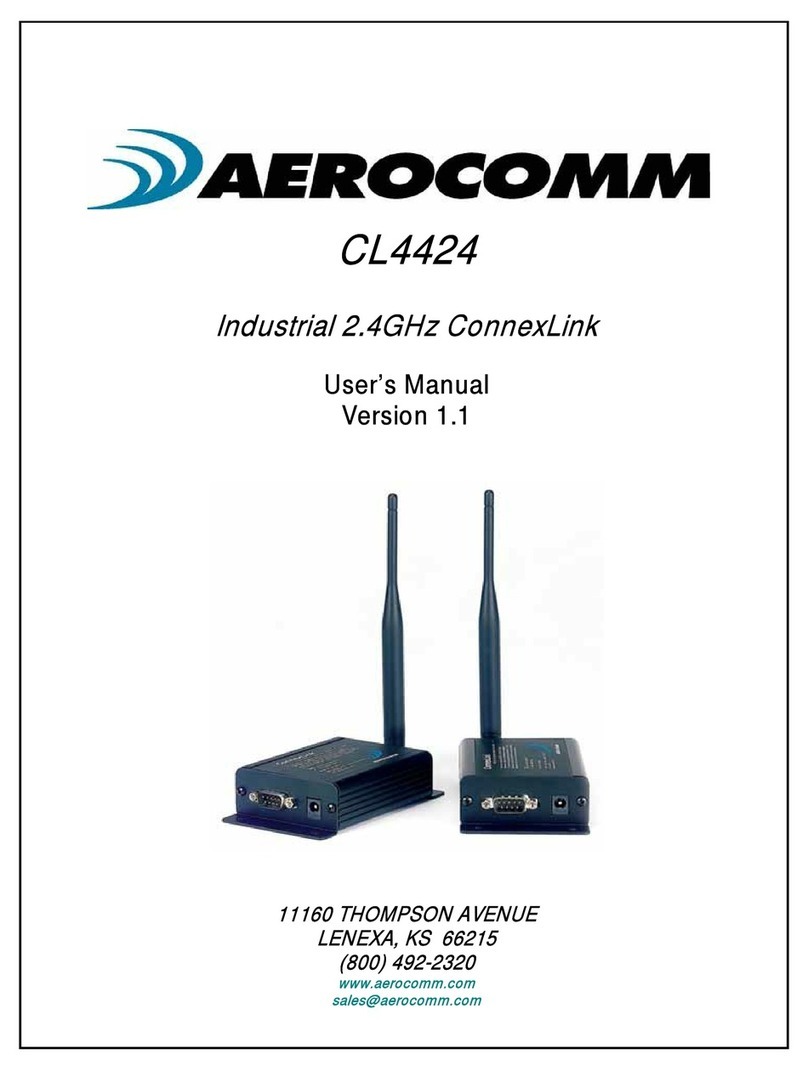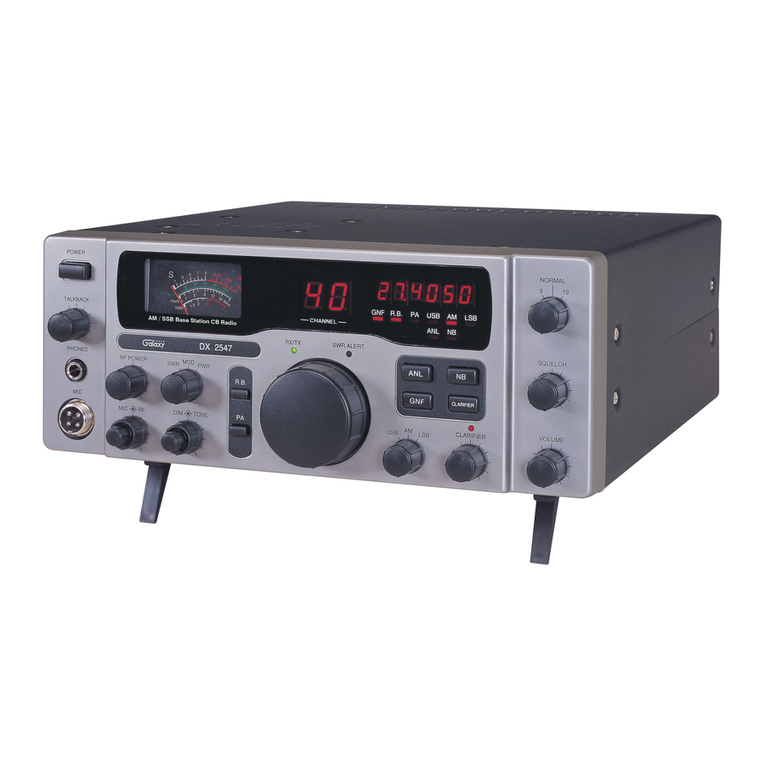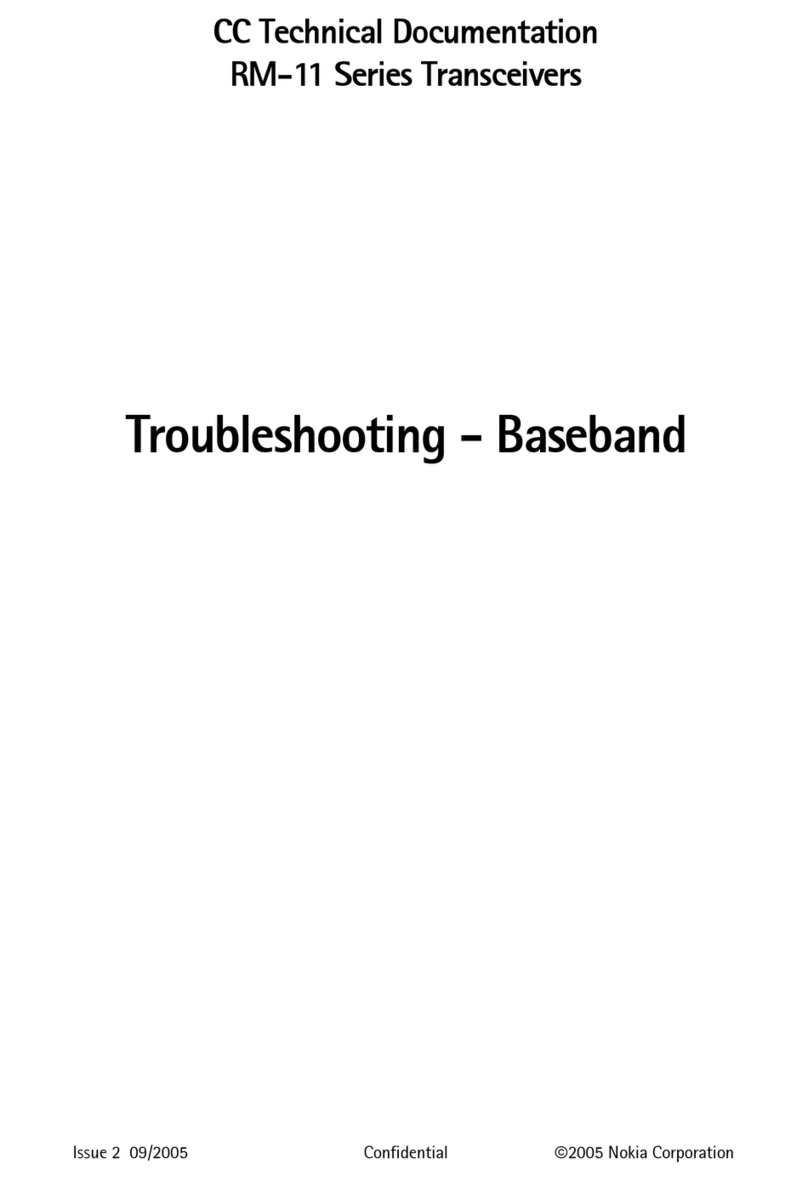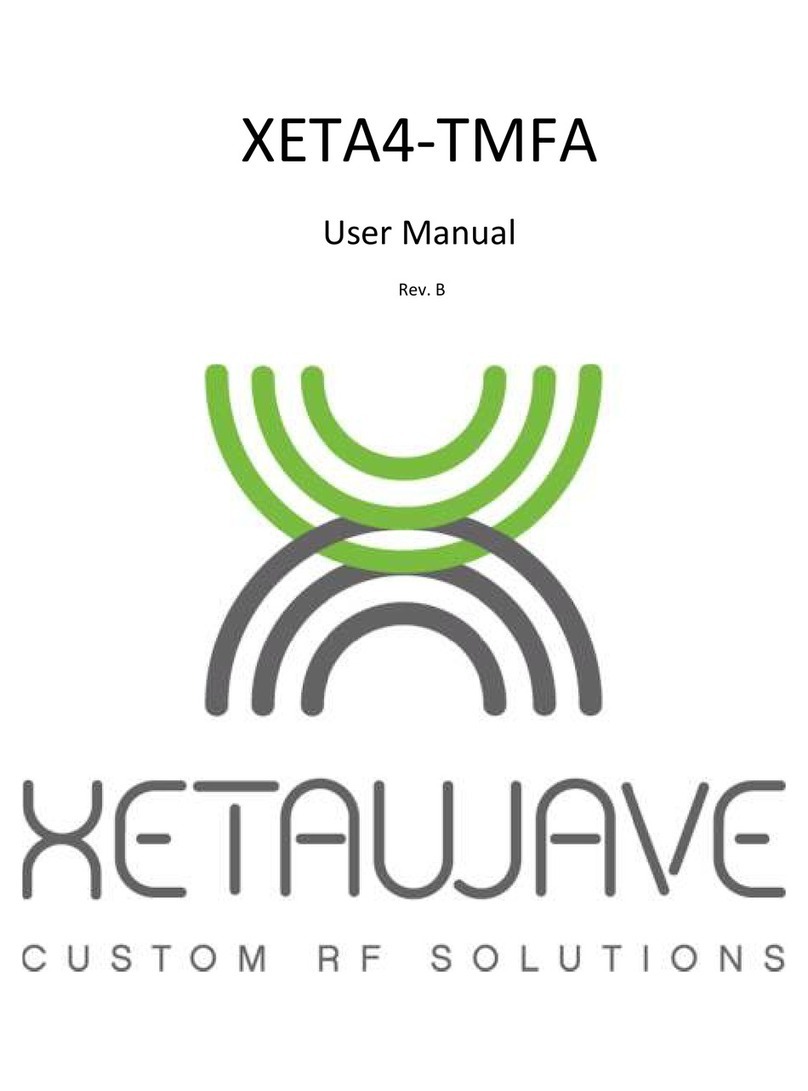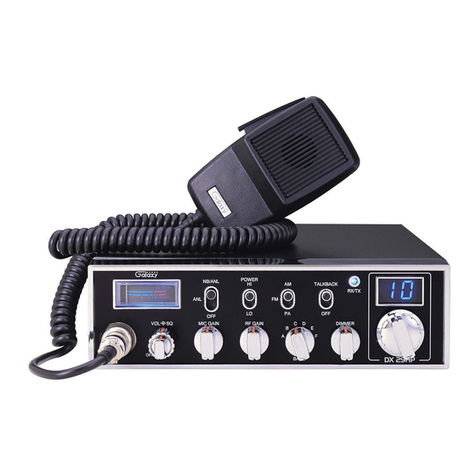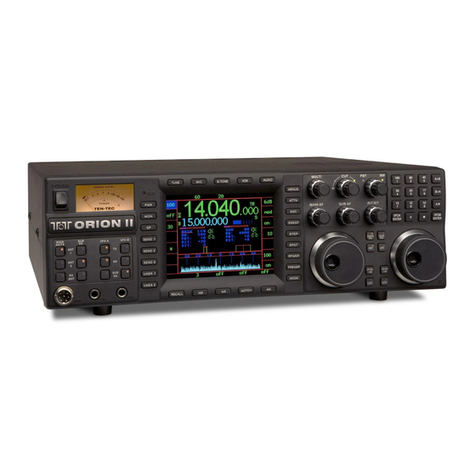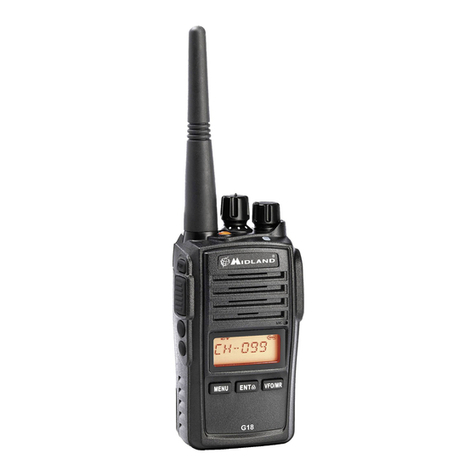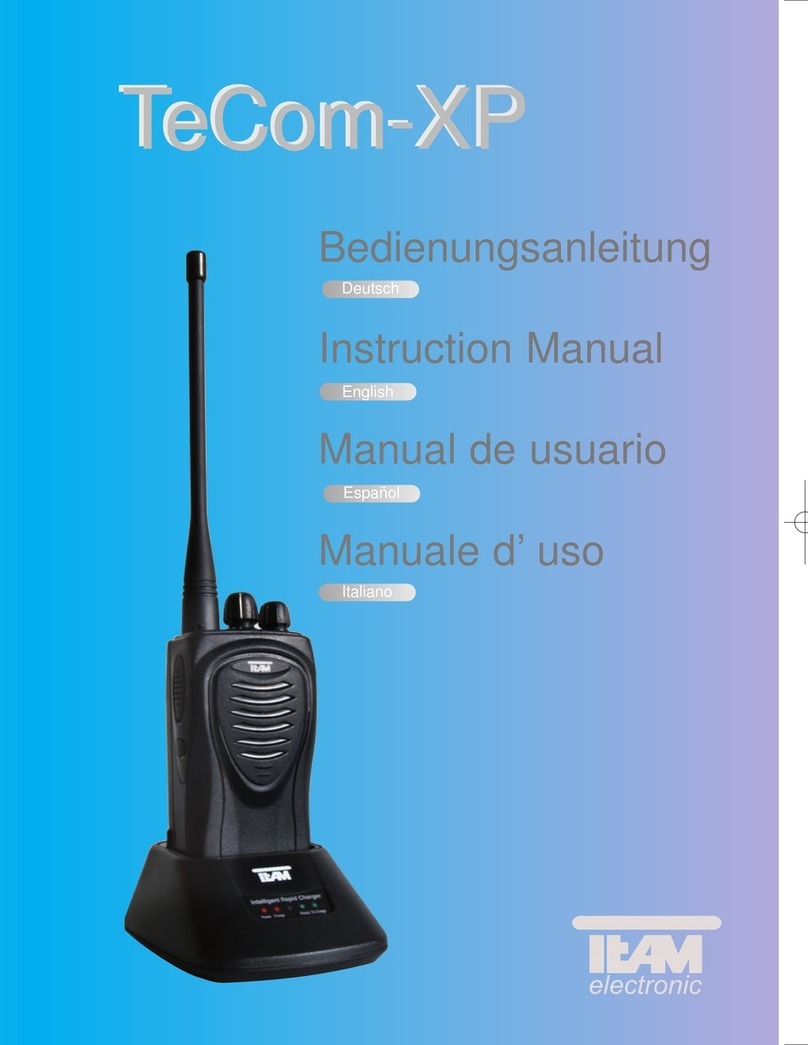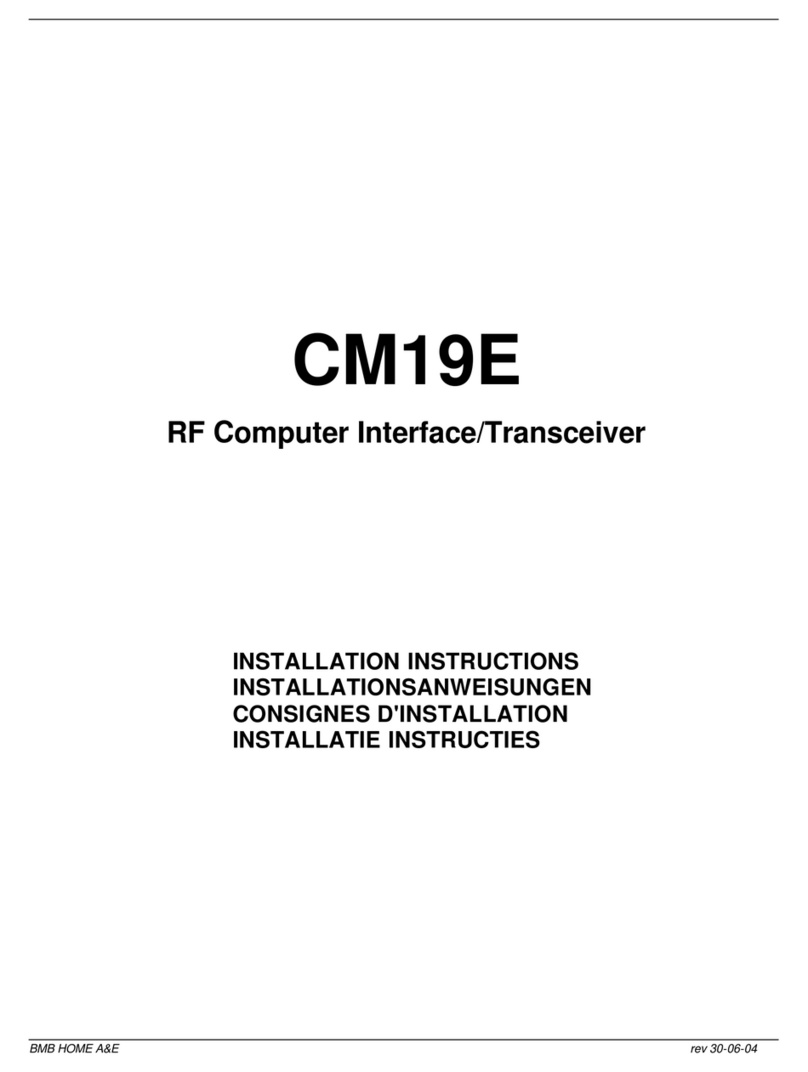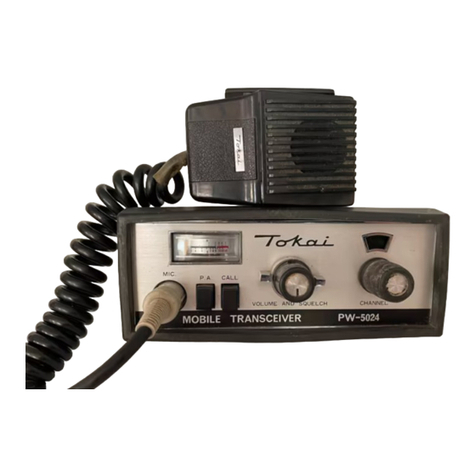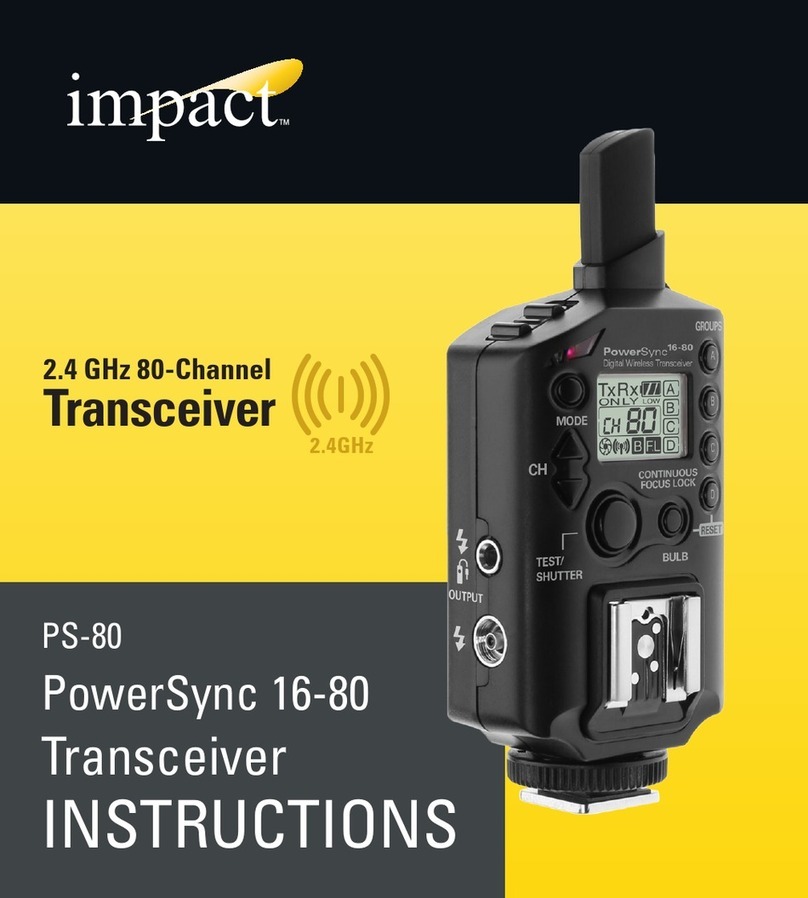Icom IC-F30GT User manual

VHF TRANSCEIVER
iC-f30gt
iC-f30gs
iC-f3 1 gt
iC-f3 1 gs

INTRODUCTION
This service manual describes the latest service information for
the IC-F30GT/GS and IC-F31GT/GS VHF TRANSCEIVER at
the time of publication.
To upgrade quality, all electrical or mechanical parts and inter-
nal circuits are subject to change without notice or obligation.
DANGER
NEVER connect the transceiver to an AC outlet or to a DC
power supply that uses more than 10 V. This will ruin the
transceiver.
DO NOT expose the transceiver to rain, snow or any liq-
uids.
DO NOT reverse the polarities of the power supply when
connecting the transceiver.
DO NOT apply an RF signal of more than 20 dBm (100
mW) to the antenna connector. This could damage the
transceiver’s front end.
ORDERING PARTS
Be sure to include the following four points when ordering
replacement parts:
1. 10-digit order numbers
2. Component part number and name
3. Equipment model name and unit name
4. Quantity required
<SAMPLE ORDER>
1110001810 S.IC TA7368F IC-F30GT MAIN UNIT 1 piece
8930053170 2337 Key board IC-F31GS CHASSIS 5 pieces
Addresses are provided on the inside back cover for your
convenience.
REPAIR NOTES
1. Make sure a problem is internal before disassembling the transceiver.
2. DO NOT open the transceiver until the transceiver is disconnected from its power source.
3. DO NOT force any of the variable components. Turn them slowly and smoothly.
4. DO NOT short any circuits or electronic parts. An insulated tuning tool MUST be used for all adjustments.
5. DO NOT keep power ON for a long time when the transceiver is defective.
6. DO NOT transmit power into a signal generator or a sweep generator.
7. ALWAYS connect a 40 dB or 50 dB attenuator between the transceiver and a deviation meter or spectrum analyser when
using such test equipment.
8. READ the instructions of test equipment thoroughly before connecting equipment to the transceiver.
INTRINSICALLY SAFE QUALIFICATION
When servicing intrinsically safe versions of the IC-F30GT/GS
and IC-F31GT/GS the following conditions must be met.
Failing to satisfy any of these conditions will invalidate the
INTRINSICALLY SAFE certification.
1. Servicing the transcever should only be undertaken by
suitably qualified personnel in a non-hazardous area.
Never attempt to remove the case in a hazardous area.
2. ONLY the approved battery, ICOM’s BP-210FM may be
used.
3. USE ONLY safety critical components as specified in the
parts list (SECTION 6), should replacement of any item
be necessary.
IC-F30GS
IC-F31GS
IC-F30GT
IC-F31GT

3
TABLE OF CONTENTS
SECTION 1 SPECIFICATIONS
SECTION 2 INSIDE VIEWS
SECTION 3 DISASSEMBLY INSTRUCTIONS
SECTION 4 CIRCUIT DESCRIPTION
4 - 1 RECEIVER CIRCUITS ................................................................................................... 4 - 1
4 - 2 TRANSMITTER CIRCUITS ............................................................................................ 4 - 2
4 - 3 PLL CIRCUITS ............................................................................................................... 4 - 3
4 - 4 FFSK CIRCUITS ............................................................................................................. 4 - 4
4 - 5 POWER SUPPLY CIRCUITS ......................................................................................... 4 - 5
4 - 6 CPU PORT ALLOCATIONS ........................................................................................... 4 - 5
SECTION 5 ADJUSTMENT PROCEDURES
5 - 1 PREPARATION ............................................................................................................... 5 - 1
5 - 2 PLL ADJUSTMENT ......................................................................................................... 5 - 4
5 - 3 SOFTWARE ADJUSTMENT ........................................................................................... 5 - 5
SECTION 6 PARTS LIST
SECTION 7 MECHANICAL PARTS AND DISASSEMBLY
SECTION 8 SEMI-CONDUCTOR INFORMATION
SECTION 9 BOARD LAYOUTS
9 - 1 FRONT UNIT .................................................................................................................. 9 - 1
9 - 2 MAIN UNIT ..................................................................................................................... 9 - 2
SECTION 10 BC-137 OPTIONAL DESKTOP CHARGER INFORMATION
SECTION 11 BLOCK DIAGRAM
SECTION 12 VOLTAGE DIAGRAM

Measurement method
Frequency coverage
Type of emission
Number of conventional channels
Power supply requirement
Current drain (approx.)
Frequency error
Usable temperature range
Dimensions (proj. not included)
Weight (approx.)
RF output power
Modulation system
Maximum permissible deviation
Spurious emissions
Adjacent channel power
Audio frequency response
Audio hormonic distortion
FM hum and noise (typical)
Residual modulation (typical)
Limitting charact of modulator
Ext. microphone connector
Receive system
Intermediate frequencies
Sensitivity (typical)
Squelch sencitivity (at threshold) (typical)
Adjcent channel selectivity (typical)
Spurious response
Intermoduration (typical)
FM hum and noise (typical)
Hum and noise (with CCITT filter) (typical)
Audio output power (at 7.2 V DC)
External SP connector
1 - 1
All stated specifications are subject to change without notice or obligation.
USA/GEN EUR
RECEIVER TRANSMITTER GENERAL
EIA-152-C/204D or TIA-603 ETS 300 086 (GEN)
136.000–174.000 MHz
16K0F3E [25 kHz; Wide], 8K50F3E [12.5 kHz; Narrow]
14K0F3E [20 kHz; Moddle], 8K50F3E [12.5 kHz; Narrow]
Max. 256 ch (16 channels ×16 banks)
7.2 V DC (negative ground; supplied battery pack)
TX at High power 2.0 A
RX rated audio 300 mA
stand-by 95 mA (typical)
±2.5 ppm ±1.5 kHz
–30˚C to +60˚C (–22˚F to +140˚F) –25˚C to +55˚C
54(W) ×139(H) ×38(D) mm; 21⁄8(W) ×515⁄32(H) ×11⁄2(D) inch
420 g; 14.8 oz (with BP-210)
5 W / 2 W / 1 W (High/Low2/Low1)
Variable reactance frequency modulation
±5.0 kHz [Wide], ±2.5 kHz [Narrow]
73 dBc typical 0.25 µW
70 dB [Wide], 60 dB [Narrow]
+2 dB to –8 dB of 6 dB/octarve
range from 300 Hz to 3000 Hz [Wide]/2550 Hz [Narrow]
3% typical at 1 kHz, 40% deviation
46 dB [Wide], 40 dB [Narrow] ——
—— 45 dB [Wide], 43 dB [Narrow]
60–100% of max. deviation
9-pin multi connector/2.2 kΩ
Double-conversion superheterodyne system
1st: 31.65 MHz, 2nd: 450 kHz
0.25 µV at 12 dB SINAD –4 dBµV (emf) at 20 dB SINAD
0.25 µV –4 dBµV (emf)
73 dB [Wide], 63 dB [Narrow]
70 dB
74 dB 70 dB
46 dB [Wide], 40 dB [Narrow] ——
—— 45 dB [Wide], 43 dB [Narrow]
500 mW typical at 5% distortion with a 8 Ωload
600 mW typical at 5% distortion with a 6 Ωload
9-pin multi connector/8 Ω
SECTION 1 SPECIFICATIONS

2 - 1
SECTION 2 INSIDE VIEWS
• FRONT UNIT
Bottom view
• MAIN UNIT
Top view
• MAIN UNIT
Bottom view
KEY LED switch
(Q1, Q2: 2SC4116)
LCD module
(DS10: EDMMU1FA0)
Internal speaker switch circuit
(Q6, Q7: CPH3403, Q8: 2SC4081,
Q9: DTC144EUA)
Expander IC
(IC1: TC74VHC373FT)
Antenna switching
(D1, D25, D24: MA77
D1 is bottom side)
D/A converter
(IC27: M62334FP)
PLL IC
(IC1: SA7025DK)
Power amplifier
(Q1: 2SK2974)
Pre-drive amplifier
(Q2: 2SK2973)
YGR amplifier
(Q3: 2SC4226)
TX/RX switch
(D5, D4: MA77)
TX/RX VCO circuit
3.58 MHz crystal
(X4: CR-563
3.579545 MHz)
PTT/MD1 switch and
INT/EXT microphone switch
(IC19: BU4053BCF)
2nd IF filter (450 kHz)
(FI2: SFPCA450KE4A)
(FI3: SFPCA450KG1A)
Discreminator
(X2: CDBCB450KCA24 450 kHz)
T5 regulator
(Q29: 2SA1362)
R5 regulator
(Q30: 2SA1362)
S5 regulator
(Q31: 2SA1362)
+5 regulator
(Q32: 2SB1132)
Crystal oscillator
for CPU clock
(X3: CR-681 12.288 MHz)
1st IF amplifier
(Q18: 2SC4215)
AF amplifier
(IC5: TA7368F)
RF amplifier
(Q20: 3SK293)
1st mixer
(Q19: 3SK206)
1st IF filter
(FI1: FL-322 31.650 MHz)
Splatter filter
(IC7: NJM2902V)
2nd mixer/IF detect
/SQL amplifier
(IC3: TA31136FN)
D/A converter
(IC13: M62364FP)
DTMF decoder
(IC17: LC73872M)
CPU
(IC14: HD64F2238FA13)
Expander IC
(IC23: BU4094BCFV)
EEPROM
(IC16, IC24: HN58X2464TI)
Microphone amplifier/mute
/compander
(IC9: TC35453F)
TCXO
(X1: CR-667
15.600 MHz )
APC amplifier
(IC4: TC75S51F)
Power detector
(D2: MA713)

3 - 1
SECTION 3 DISASSEMBLY INSTRUCTIONS
1 Removing the chassis panel
2 Removing the shield plate
3 Removing the MAIN unit
4 Removing the FRONT unit
qRemove 2 knobs A, and unscrew 1 nut B.
wUnscrew 1 screw C(ICOM screw), and 2 screws D(2 ×
4 mm, black) from the 9-pin connector.
eUnscrew 2 screws E(2 ×8 mm, silver) from the chassis.
rTa ke off the chassis in the direction of the arrow.
qUnplug the flexible cable from J1 on the FRONT unit to
separate the chassis.
wTa ke off the flexible cable in the direction of the arrow.
eUnscrew 8 screws F(2 ×3 mm, black) to separate the
shield plate.
qUnsolder 2 points G.
wUnscrew 2 nuts H.
eUnscrew 6 screws I(2 ×4 mm, silver), and 2 screws J
(2 ×4 mm, black) from the MAIN unit.
rTa ke off the MAIN unit in the direction of the arrow.
qUnplug the LCD flexible cable from J2 on the FRONT unit
to separate the front panel.
wUnscrew 6 screws K(2 ×3.5 mm, silver) from the FRONT
unit.
eUnsolder the leads of speaker.
A
B
C
D
E
Chassis
Front panel
9-pin connector
Shield plate
MAIN unit
Chassis
Flexible cable
F
F
F
F
MAIN unit
Chassis
Nut
H
J
I
G
I
Front panel
Front unit
J2
J1
LCD flexible cable
K
K

4 - 1
SECTION 4 CIRCUIT DESCRIPTION
4-1 RECEIVER CIRCUITS
4-1-1 ANTENNA SWITCHING CIRCUIT
The antenna switching circuit functions as a low-pass filter
while receiving and a resonator circuit while transmitting.
This circuit does not allow transmit signals to enter the
receiver circuits.
Received signals enter the antenna connector (CHASSIS;
MP44) and pass through the low-pass filter (L1–L3, C1–C3,
C416–C419). The filtered signals are passed through the λ⁄4
type antenna switching circuit (D25, L39, D24) and then
applied to the RF circuit.
4-1-2 RF CIRCUIT
The RF circuit amplifies signals within the range of frequen-
cy coverage and filters out-of-band signals.
The signals from the antenna switching circuit pass through
the two-stage tunable bandpass filters (D21, D20, L38, L37).
The filtered signals are amplified at the RF amplifier (Q20)
and then passed through the another two-stage tunable
bandpass filters (D19, D18, L36, L33) to suppress unwant-
ed signals. The filtered signals are applied to the 1st mixer
circuit.
D18–D21 employ varactor diodes, that are controlled by the
CPU via the D/A converter (IC27), to track the bandpass fil-
ter. These varactor diodes tune the center frequency of an
RF pass band for wide bandwidth receiving and good image
response rejection.
4-1-3 1ST MIXER AND IST IF CIRCUITS
The 1st mixer circuit converts the received signal into fixed
frequency of the 1st IF signal with the PLL output frequency.
By changing the PLL frequency, only the desired frequency
passes through a cristal filter at the next stage of the 1st
mixer.
The RF signals from the bandpass filter are mixed with the
1st LO signals, where come from the RX VCO circuit via the
attenuator (R360–R358), at the 1st mixer circuit (Q19) to
produce a 31.65 MHz 1st IF signal. The 1st IF signal is
passed through a monolithic filter (FI1) in order to obtain
selection capability and to pass only the desired signals. The
filtered signal is applied to the 2nd IF circuit after being
amplified at the 1st IF amplifier (Q18).
4-1-4 2ND IF AND DEMODULATOR CIRCUITS
The 2nd mixer circuit converts the 1st IF signal into a 2nd IF
signal. The double-conversion superheterodyne system
(which convert receive signals twice) improves the image
rejection ratio and obtains stable receiver gain.
The 1st IF signal from the IF amplifier (Q18) is applied to the
2nd mixer section of the FM IF IC (IC3, pin 16), and is mixed
with the 2nd LO signal to be converted into a 450 kHz 2nd
IF signal.
The FM IF IC (IC3) contains the 2nd mixer, 2nd local oscil-
lator, limiter amplifier, quadrature detector, active filter and
noise amplifier circuits. A 2nd LO signal (31.2 MHz) is pro-
duced at the PLL circuit by doubling it’s reference frequency
(15.6 MHz).
The 2nd IF signal from the 2nd mixer (IC3, pin 3) passes
through the ceramic filters (FI2, FI3) during narrow channel
spacing selection or FI2 only (bypassing FI3) during wide
channel spacing selection to remove unwanted heterodyned
frequencies. It is then amplified at the limiter amplifier sec-
tion (IC3, pin 5) and applied to the quadrature detector sec-
tion (IC3, pins 10, 11) to demodulate the 2nd IF signal into
AF signals.
The demodulated AF signals are output from pin 9 (IC3) and
applied to the AF circuit via the receiver mute circuit.
• 2nd IF and demodulator circuits
Mixer
16
Limiter
amp.
2nd IF filter
450 kHz X1
15.6 MHz
31.2 MHz
IC3 TA31136FN
12 1st IF from the IF amplifier (Q18)
"RSSI" signal to the CPU (IC14, pin 50)
11109
87
AF signal "DSIN"
R5V
X2
Squelch level
controller (IC13) 2
Active
filter
Noise
detector
FM
detector
13
"NOIS" signal to the CPU (IC14, pin 75)
RSSI
Noise
comp.
×2
Doubler
Q15
23
24
FI2
5
FI3
3

4 - 2
4-1-5 AF AMPLIFIER CIRCUIT
The AF amplifier circuit amplifies the demodulated AF sig-
nals to drive a speaker.
The AF signals from the FM IF IC (IC3, pin 9) are amplified
at the AF amplifier section of the compander IC (IC9, pins 5,
4) and are then applied to the high-pass filter circuit (IC7a).
The high-pass filter characteristics are controlled by the
FSW signal from the I/O expander IC (IC23, pin 14). When
FSW signal is high, the cut-off frequency is shifted higher to
remove CTCSS or DTCS signals.
The filtered AF signals from the high-pass filter (IC7a, pin 1)
are applied to the de-emphasis section of compander IC
(IC9, pin 3) with frequency characteristics of –6 dB/octave,
and are then passed through the low-pass filter, high-pass
filter, expander sections of compander IC (IC9). The output
signal from IC9 (pin 38) is applied to the electronic volume
controller (IC13, pin 1).
The output AF signals from the electronic volume controller
(IC13, pin 2) are applied to the AF power amplifier (IC5) to
drive the speaker.
4-1-6 RECEIVE MUTE CIRCUITS
• NOISE SQUELCH
A squelch circuit cuts out AF signals when no RF signals are
received. By detecting noise components in the AF signals,
the squelch circuit switches the AF mute switch.
Some noise components in the AF signals from the FM IF IC
(IC3, pin 9) are passed through the level controller (IC13,
pins 24, 23). The level controlled signals are applied to the
active filter section in the FM IF IC (IC3, pin 8). Noise com-
ponents about 10 kHz are amplified and output from pin 7.
The filtered signals are converted into the pulse-type signals
at the noise detector section and output from pin 13 (NOIS).
The NOIS signal from the FM IF IC is applied to the CPU
(IC14, pin 75). Then the CPU analyzes the noise condition
and controls the AF mute signal via “AFMT”line (IC23, pin
13) to the AF regulator (Q23, Q24).
•CTCSS AND DTCS
The tone squelch circuit detects AF signals and opens the
squelch only when receiving a signal containing a matching
subaudible tone (CTCSS or DTCS). When tone squelch is in
use, and a signal with a mismatched or no subaudible tone
is received, the tone squelch circuit mutes the AF signals
even when noise squelch is open.
A portion of the AF signals from the FM IF IC (IC3, pin 9)
passes through the low-pass filter (IC20b/a) to remove AF
(voice) signals and is applied to the CTCSS or DTCS
decoder inside of the CPU (IC14, pin 46) via the “RXDT”line
to control the AF mute switch via the I/O expander IC (IC23).
4-2 TRANSMITTER CIRCUITS
4-2-1 MICROPHONE AMPLIFIER CIRCUIT
The microphone amplifier circuit amplifies audio signals
within +6 dB/octave pre-emphasis characteristics from the
microphone to a level needed for the modulation circuit.
The AF signals (MIC+) from the FRONT unit via J3 (pin 22)
are passed through the internal/extenal microphone switch
(IC19, pins 12, 14) and level controller (IC13, pins 9, 10) to
the microphone amplifier circuit.
The AF signals from the level controller (IC13) are applied to
the microphone amplifier section of compander IC (IC9, pin
12). The amplified signals are passed through the compres-
sor, low-pass filter and high-pass filter sections of IC9.
The filtered AF signals are amplified at the buffer amplifier
(Q47) and pre-emphasized with +6dB/octave at the pre-
emphasis circuit (C203, R166), and are then applied to the
IDC amplifier section of IC9 (pin 8).
The amplified AF signals are passed through the limitter
amplifier and low-pass filter sections of IC9 after being
passed through the AF mute switch inside of IC9.
The output signals from pin 6 are passed through the splat-
ter filter (IC7c) and level controller (IC13, pins 21, 22), and
are then applied to the modulation circuit (D7).
4-2-2 MODULATION CIRCUIT
The modulation circuit modulates the VCO oscillating signal
(RF signal) using the microphone audio signals.
The AF signals from the level controller (IC13) change the
reactance of varactor diode (D7) to modulate the oscillated
signal at the TX VCO circuit (Q12, D8, D43–D45). The mod-
ulated VCO signal is amplified at the buffer amplifiers (Q8,
Q6) and is then applied to the drive amplifier circuit via the
T/R switch (D4).
The CTCSS/DTCS signals from the CPU (IC14, pin 44) are
passed through the low-pass filter (IC7d), level controller
(IC13, pins 12, 11) and mixer circuit (IC7b), and are then
applied to the VCO circuit via the splatter filter (IC7c).
4-2-3 DRIVE/POWER AMPLIFIER CIRCUITS
The drive/power amplifier circuits amplify the VCO oscillat-
ing signal to an output power level.
The signal from the VCO circuit passes through the T/R
switch (D4), and is amplified at the YGR (Q3), drive (Q2),
power (Q1) amplifiers to obtain 5 W of RF power (at 7.2 V
DC).
The amplified signal is passed through the APC detector,
antenna switching circuit (D1) and low-pass filter, and is
then applied to the antenna connector.
The bias current of the drive (Q2) and power (Q1) amplifiers
is controlled by the APC circuit.

4 - 3
4-2-4 APC CIRCUIT
The APC circuit (IC4, Q22) protects the drive and power
amplifiers from excessive current drive, and selects output
power of HIGH, LOW2 or LOW1.
The power detector circuit (D2) detects the transmit power
output level and converts it into DC voltage. The output volt-
age is at a minimum level when the antenna impedance is
matched at 50 Ωand is increased when it is mismatched.
The detected voltage is applied to the differential amplifier
(IC4, pin 3), and the “T4”signal from the D/A converter
(IC27, pin 4), controlled by the CPU (IC14), is applied to the
other input for reference. When antenna impedance is mis-
matched, the detected voltage exceeds the power setting
voltage. Then the output voltage of the differential amplifier
(IC4, pin 4) controls the input current of the drive amplifier
(Q2) and power amplifier (Q1) to reduce the output power.
4-3 PLL CIRCUITS
4-3-1 PLL CIRCUIT
A PLL circuit provides stable oscillation of the transmit fre-
quency and receive 1st LO frequency. The PLL output com-
pares the phase of the divided VCO frequency to the refer-
ence frequency. The PLL output frequency is controlled by
the divided ratio (N-data) of a programmable divider.
The PLL circuit contains the TX/RX VCO circuit (Q12, Q11).
The oscillated signal is amplified at the buffer amplifiers (Q8,
Q7) and then applied to the PLL IC (IC1, pin 5).
The PLL IC contains a prescaler, programmable counter,
programmable divider and phase detector, etc. The entered
signal is divided at the prescaler and programmable counter
section by the N-data ratio from the CPU. The divided signal
is detected on phase at the phase detector using the refer-
ence frequency.
If the oscillated signal drifts, its phase changes from that of
the reference frequency, causing a lock voltage change to
compensate for the drift in the oscillated frequency.
4-3-2 VCO CIRCUIT
The VCO circuit contains a separate RX VCO (Q11, D6,
D40–D42) and TX VCO (Q12, D7, D8, D43–D45). The oscil-
lated signal is amplified at the buffer amplifiers (Q8, Q6) and
is then applied to the T/R switch (D5, D4). Then the receive
1st LO (Rx) signal is applied to the 1st mixer (Q19) and the
transmit (Tx) signal to the YGR amplifier circuit (Q3).
A portion of the signal from the buffer amplifier (Q8) is fed
back to the PLL IC (IC1, pin 5) via the buffer amplifier (Q7)
as the comparison signal.
•PLL circuit
Shift register
×2
Prescaler
Phase
detector
Loop
filter
Programmable
counter
Programmable
divider
X1
15.6 MHz
31.2 MHz signal
to the FM IF IC 8
Buffer
Q8
Buffer
Q6
Buffer
Q7
Doubler
1
2
3
SCK
SO
PLST
to transmitter circuit
to 1st mixer circuit
D4
D5
14 5
Q15
IC1 SA7025DK-T
Q12, D7, D8, D43–D45
TX VCO
Q11, D6, D40–D42
RX VCO
•APC circuit
Q1
Power
amp.
Q2
Driver
amp.
IC4
+
–
T5V
RF signal
from PLL to antenna
T4
TMUT
Q22
S5V
APC control circuit
Power detector
circuit (D2)
D2
L5

4 - 4
4-4 FFSK CIRCUIT DESCRIPTION
4-4-1 GENERAL
IC9 is the compounder IC which is controlled by serial data
bus line (“TRD”, “MSKE”, “DIN”, “SCK”, “APST”, “REGS1”,
“REGS2”, “RTM”, “RDT”, “FCLR” signals) from the CPU.
The IC is composed of FFSK transmitting and receiving cir-
cuits, data register circuits, transmitting and receiving data
buffer circuits, and so on.
X4 is oscillated 3.58 MHz reference signal to the IC9.
4-4-2 DECODEING CIRCUIT
The input signal from the FM IC (IC3, pin 9) via the “DSIN”
signal is applied to the compounder IC (IC9, pin 5), and is
then detected bit synchronization detection within 16 bit.
4-4-3 ENCODEING CIRCUIT
The FFSK signal is made by serial data bus line signals, and
is then output from the compounder IC (IC9, pin 6).
In case of the FFSK signal is used for the PM modulation,
the FM/PM switch (IC29) is changed to pin 3.
In case of the FFSK signal is used for the FM modulation,
the FM/PM switch (IC29) is changed to pin 5.
The output signal from IC29, pin 4 is applied to the the buffer
amplifier (IC7, pins 8, 10), and is applied to the D/A conver-
tor IC (IC13, pins 21, 22). The signal is applied to the mod-
ulation circuit (Q12, D7, D8, D43–D45).
COMPRE-
MSK
MOD
MSK
DEMOD
B
EXPAN-
DER
COMPANDER
IC9 TC35453F
SSOR
MCIN
X4
Q47
2SC4081 MCOT
CR-563
3.58 MHz
29, MSKE
30, TRD
23, DIN
25, REGS1
26, REGS2
31, RTM
32, RDT
33, FCLR
IDCIN
TXFO
8
1
RXFO
MICIN
TXOUT
12
3
RXIN
5
MSKIN
28
27
6
9
22, SCK
22, APST
SERIAL DATA LINE
LPF
AMP
LIMIT
AMP
AMP
HPF
LPF
AMP
BUFF
HPF
LPF
AMP
BPF
HPF
AMP
• Conpounder IC block diagram

4 - 5
4-5POWER SUPPLYCIRCUIT
VOLTAGE LINE
4-6PORT ALLOCATIONS
4-6-1 CPU (IC14)
4-6-2 I/O EXPANDER (IC23)
LINE
HV
VCC
CPU5V
+5V
S5V
T5V
R5V
DESCRIPTION
The voltage from the attached battery pack.
The same voltage as the HV line (battery volt-
age) which is controlled by the power swtich
([VOL] control).
Common 5 V converted from the VCC line by the
reference regulator circuit (IC12). The output volt-
age is applied to the CPU (IC14), 5 V regulator cir-
cuit (Q32, Q33) and reset circuit (IC15), and etc.
Common 5 V converted from the VCC line by the
+5V regulator circuit (Q32, Q33).
Common 5 V converted from the +5V line by the
S5V regulator circuit (Q31).
5 V for transmitter circuits regulated by the T5V
regulator circuit (Q29).
5 V for receiver circuits regulated by the R5V
regulator circuit (Q30).
Outputs data signals for the PLL IC
(IC1), compamder IC (IC9), expander
IC (IC23), D/A converter (IC13), etc.
Outputs strobe signals to the D/A con-
verter (IC13).
Output clock signal to the DTMF
decoder (IC17).
Outputs single tone signal.
Outputs CTCSS/DTCS tone signal.
Single tone signal input port for decod-
ing.
CTCSS/DTCS signals input port for
decoding.
Input port for the volume control [VOL].
High : [VOL] is maximum clockwise.
Input port for the PLL lock voltage.
Input port for the RSSI detection.
Input port for the reset signal.
Outputs serial data signals to the
DTMF decoder IC (IC17).
Outputs transmit mute signal.
Low : During unlock or while muted
Outputs R5 regulator control signal.
Low: While receiving
Outputs T5 regulator control signal.
Low: While transmitting
Input port for noise signals (pulse-
type) for noise squelch operation.
I/O port for data signals from/to the
D/A converter (IC27).
I/O port for data signals from/to
EEPROMs (IC16, IC24).
Outputs beep audio signals.
Outputs clock signal to EEPROMs
(IC16, IC24).
Outputs clock signal to the D/A con-
verter (IC27).
SO
DAST
DTAC
SENC
CTDA
SDEC
RXDT
AFVI
LVIN
RSSI
RES
DTSD
TMUT
R5C
T5C
NOIS
SDA
MSO
BEEP
MSCK
SCL
35
36
39
43
44
45
46
47
49
50
59
68
70
71
73
75
81
82
87
94
95
4
5
6
7
13
15
16
17,
18,
19,
21
22–
25
26
28
29
34
RESB
RMUT
MMUT
PTOT
EXST
APST
DIN
RGS1,
RGS2,
MSKE,
FCLR
CB10–
CB13
VCOS
PLST
ULCK
SCK
Outputs reset signal for the expader IC
(IC23).
Input port for AF mute signal from the
optional units via J1 or J2.
Input port for MIC mute signal from the
optional units via J1 or J2.
Input port for the [PTT] switch
Low : While [PTT] switch is pushed.
Outputs strobe signals to the expander
IC (IC23).
Outputs strobe signals to the compan-
der IC (IC9).
Outputs serial data signals to the com-
pander IC (IC9).
Output control signal for the compan-
der IC (IC9).
Outputs reset signal for the compan-
der IC (IC9).
Input ports for rotary selector [SEL].
Outputs TX VCO/RX VCO switching
signal for the VCO switch (Q9, Q10).
High : While transmitting
Outputs strobe signals to the PLL IC
(IC1).
Input port for the PLL unlock signal.
Low : PLL is unlocked.
Outputs clock signal for the PLL IC
(IC1), compamder IC (IC9), expander
IC (IC23), D/A converter (IC13), etc.
Pin Port Description
number name
Pin Port Description
number name
4
6
7
11
12
13
14
BUSY
DUSE
W/N
S5C
SPCN
AFMT
FSW
Outputs BUSY detection.
Low : The channel is busy.
Outputs low-pass filter cut-off frequen-
cy control signal when DTCS is acti-
vated.
Outputs IF bandwidth control signal.
High : While IF bandwidth is narrow.
Outputs S5 regulator control signal.
Outputs internal speaker select signal.
Outputs control signal for the AF
amplifier regulator circuit.
High: While AF amp. is activated.
Outputs high-pass filter’s characteris-
tics select signal.
Pin Port Description
number name

5 - 1
5-1 PREPARATION
When you adjust the contents on pages 5-5 and 5-6, SOFTWARE ADJUSTMENT, the optional CS-F30G ADJ ADJUSTMENT SOFT-
WARE (Rev. 1.0 or later), *OPC-966 JIG CABLE (modified OPC-966 CLONING CABLE) are required.
■REQUIRED TEST EQUIPMENT
SECTION 5 ADJUSTMENT PROCEDURES
■SYSTEM REQUIREMENTS
•IBM PC compatible computer with an RS -232C serial port
(38400 bps or faster).
•Microsoft Windows 95 or Windows 98
•Intel i486DX processor or faster (Pentium 100 MHz or
faster recommended)
•At least 16 MB RAM and 10 MB of hard disk space
•640×480 pixel display (800×600 pixel display recommend-
ed)
■ADJUSTMENT SOFTWARE INSTALLATION
qBoot up Windows.
- Quit all applications when Windows is running.
wInsert the ‘CS-F30G’into the appropriate drive.
eSelect ‘Run’from the [Start] menu.
rType the setup program name using the full path name,
then push [Enter] key.
(ex. D:\CSF30GADJ\disk1\Setup.exe)
tFollow the prompts.
yProgram group ‘CS-F30G ADJ’appears in the ‘Programs’
folder of the [Start] menu.
■STARTING SOFTWARE ADJUSTMENT
qConnect IC-F30GT, F30GS, F31GT or F31GS and PC
with *OPC-966 JIG CABLE.
wTurn the transceiver power ON.
eBoot up Windows, and click the program group ‘CS-F30G
ADJ’in the ‘Programs’folder of the [Start] menu, then
CS-F30G ADJ’s window appears.
rClick ‘Connect’on the CS-F30G’s window, then appears
IC-F30GT, F30GS, F31GT or F31GS’s up-to-date condi-
tion.
tSet or modify adjustment data as desired.
IBM is a registered trademark of International Bussiness
Machines Corporation in the U.S.A. and other countries.
Microsoft and Windows are registered trademarks of
Microsoft Corporation in the U.S.A. and other countries.
Screen shots produced with permission from Microsoft
Corporation. All other products or brands are registered
trademarks or trademarks of their respective holders.
•High power transmittion
When you adjust the output power (high power), the battery
type detector must be connected to GND (see illustration at
below). Otherwise the transceiver does not transmit high
power, the output power will be low.
EQUIPMENT
DC power supply
FM deviation meter
Frequency counter
Digital multimeter
RF power meter
(terminated type)
GRADE AND RANGE
Output voltage : 7.5 V DC
Current capacity : 5 A or more
Frequency range : DC–300 MHz
Measuring range : 0 to ±10 kHz
Frequency range : 0.1–300 MHz
Frequency accuracy : ±1 ppm or better
Sensitivity : 100 mV or better
Input impedance : 10 MΩ/V DC or better
Measuring range : 1–10 W
Frequency range : 100–300 MHz
Impedance : 50 Ω
SWR : Less than 1.2 : 1
EQUIPMENT
Audio generator
Attenuator
Standard signal
generator (SSG)
DC voltmeter
Oscilloscope
AC millivoltmeter
GRADE AND RANGE
Frequency range : 300–3000 Hz
Output level : 1–500 mV
Power attenuation : 40 or 50 dB
Capacity : 10 W or more
Frequency range : 100–300 MHz
Output level : 0.1 µV–32 mV
(–127 to –17 dBm)
Input impedance : 50 kΩ/V DC or better
Frequency range : DC–20 MHz
Measuring range : 0.01–20 V
Measuring range : 10 mV–10 V
Battery type detector
+
–
DC power supply
7.5 V/5.0 A
Battery type detector
Connect to GND

5 - 2
CS-F30G ADJ Rev.1.0
File
COM 1: OPEN
Option
Connect Reload (F5) Disp para
[A / D]
VIN : 197 : C5h : 7.73 V
TEMPS : 190 : BEh : 32.23 'C
LVIN : 67 : 43h : 1.31 V
SD : 27 : 1Bh : 0.53 V
BDET : 0 : 00h : 0.00 V (Ni-Cd, Ni-MH)
Power (Hi) : 98 [ # # # # # # # # –––––––––––]
Power (L2) : 54 [ # # # # –––––––––––––––]
Power (L1) : 54 [ # # –––––––––––––––––]
Ballance : 132 [ # # # # # # # # # # –––––––––]
MOD W : 95 [ # # # # # # # ––––––––––––]
MOD N : 47 [ # # # # –––––––––––––––]
CTCS/DTCS : 113 [ # # # # # # # # # ––––––––––]
SQL : 0 [ –––––––––––––––––––]
BPF ALL : [Enter] to sweep
BPF T1 : 23 [ # # # # # # # # # # # # –––––––] [Enter] to sweep
BPF T2 : –22 [ # # # # # # # # –––––––––––] [Enter] to sweep
BPF T3 : 9 [ # # # # # # # # # # # ––––––––] [Enter] to sweep
BPF T4 : –7 [ # # # # # # # # # ––––––––––] [Enter] to sweep
TXF : [Enter] to start
S-METER : [Enter] to start
[D / A]
BPF T1 : 90 : 5Ah : 1.76 V
BPF T2 : 45 : 2Dh : 0.88 V
BPF T3 : 76 : 4Ch : 1.49 V
T4/POW : 60 : 3Ch : 1.18 V
REF : 112 : 70h : 2.20V
MOD BAL : 90 : 5Ah : 1.76 V
Dev : 45 : 2Dh : 0.88 V
CTCSS : 76 : 4Ch : 1.49 V
SQL Lev : 0 : 00h : 1.18 V
CH No. : 01 RX Freq = 155.000, TX Freq = <–RF Power: Low1 Mode: Wide
: Transceiver's connection state
: Reload adjustment data
: Receive sensitivity measurement
: Connected DC voltage
: PLL lock voltage
: Operating channel select
: RF output power
: Modulation balance
NOTE:
•Screen display exampe
1
5
4
6
10
11
12
15
9
14
16
1
2
3
4
5
6
9
10
7
8
11
12
13
: FM deviation
: CTCSS/DTCS deviation
: Squelch level
: Receive sensitivity (automatically)
: Receive sensitivity (manually)
: Reference frequency
: S-meter
: Adjustment items
14
15
16
The above values for settings are example only.
Each transceiver has its own specific values for each setting.
3
2
8
7
13

5 - 3
+
+
–
Audio generator
300 Hz to 3 kHz
AC
millivoltmeter
SP+
SP–
MICE
MIC
PTT
PTTE
Add a jumper wire here
•*OPC-966 (JIG CABLE)
Electrolytic capacity
47 µF
OPC-966
(Cloning cable)
SINAD meter
Speaker (8 Ω)
Audio generator
•Connection
to the antenna connector
RF power meter
0.1–10 W/50 Ω
Frequency
counter
Attenuator
40 dB or 50 dB
FM
deviation meter
Standard signal generator
0.1 µV to 32 mV
(–127 dBm to –17 dBm)
CAUTION:
DO NOT transmit while
SSG is connected to the
antenna connector.
to an RS-232C port
DB9 female plug
(incl. level converter circuit)
Personal
computer
RS-232C cable (straight) *OPC-966
(JIG CABLE)

5 - 4
5-2 PLL ADJUSTMENT
PLL LOCK
VOLTAGE
1
2
3
4
•Operating freq. : 136.000 MHz
•Receiving
•Transmitting
•Operating freq. : 174.000 MHz
•Receiving
•Transmitting
MAIN Connect a digital multi-
meter or an oscillo-
scope to the check
point, “LV”.
1.2 V
1.0 V
3.0–4.5 V
MAIN C372
C373
Verify
ADJUSTMENT ADJUSTMENT CONDITIONS
UNIT LOCATION
VALUE
UNIT ADJUST
MEASUREMENT ADJUSTMENT
LV
PLL lock voltage
check point
C372
PLL lock voltage
adjustment for RX
C373
PLL lock voltage
adjustment for TX
•MAIN unit

5 - 5
5-3 SOFTWARE ADJUSTMENT
Select an operation using [↑] / [↓] keys, then set specified value using [←] / [→] keys on the connected computer keyboard.
1
1
2
3
1
1
2
1
•Operating freq. : 174.000 MHz
•Output power : Low1
•Connect an RF power meter or 50 Ω
dummy load to the antenna connector.
•Transmitting
•Operating freq. : 136.000 MHz
•Output power : High
•Transmitting
•Output power : Low2
•Transmitting
•Output power : Low1
•Transmitting
•Operating freq. : 155.000 MHz
•Output power : Low1
•Set an FM deviation meter as:
HPF : OFF
LPF : 20 kHz
De-emphasis : OFF
Detector : (P–P)/2
•Push [P0] key while transmitting
•Operating freq. : 155.000 MHz
•Output power : Low1
•IF bandwidth : Wide
•Set the FM deviation meter as:
HPF : OFF
LPF : 20 kHz
De-emphasis : OFF
Detector : (P–P)/2
•Connect the audio generator to the multi
connector through the JIG cable (*OPC-
966) and set as :
1.0 kHz/150 mVrms
•Transmitting
•IF bandwidth : Narrow
•Transmitting
•Operating freq. : 155.000 MHz
•Output power : Low1
•IF bandwidth : Wide
•CTCSS : 88.5 Hz
•DTCS code : 007
•No audio applied to the [MIC] input.
•Transmitting
REFERENCE
FREQUENCY
[TXF]
OUTPUT
POWER
[Power (Hi)]
[Power (L2)]
[Power (L1)]
MODULATION
BALLANCE
[Ballance]
FM
DEVIATION
[MOD W]
[MOD N]
CTCSS/DTCS
DEVIATON
[CTCS/DTCS]
Top
panel
Top
panel
Top
panel
Top
panel
Top
panel
Loosely couple a frequnecy
counter to the antenna connec-
tor.
Connect an RF power meter to
the antenna connector.
Connect an FM deviation meter
with an oscilloscope to the
antenna connector through an
attenuator.
Connect an FM deviation meter
to the antenna connector
through the attenuator.
Connect an FM deviation meter
to the antenna connector
through the attenuator.
174.0000 MHz
5.0 W
2.0 W
1.0 W
±4.1 kHz A
±3.1 kHz B
±2.1 kHz
±0.70 kHz 1
±0.56 kHz 2
ADJUSTMENT ADJUSTMENT CONDITION MEASUREMENT VALUE
UNIT LOCATION
Set to flat wave
form
A: W/N version, B: M/N version

5 - 6
*The output level of the standard signal generator (SSG) is indicated as the SSG’s open circuit.
SOFTWARE ADJUSTMENT – continued
Select an operation using [↑] / [↓] keys, then set specified value using [←] / [→] keys on the connected computer keyboard.
Minimum distortion
level
Set “SQL level”to
close squelch.
Then set “SQL level”
at the point where
the audio signals
just appears.
1
1
2
1
•Operating freq. : 136.000 MHz
•IF bandwidth : Wide
•Connect a standard signal generator to
the antenna connector and set as:
Frequency : 136.000 MHz
Level : 10 µV* (–87 dBm)
Modulation : 1 kHz
Deviation : ±3.5 kHz A
±2.8 kHz B
•Receiving
•Operating freq. : 136.000 MHz
•IF bandwidth : Wide
•Connect an SSG to the antenna con-
nector and set as:
Frequency : 136.000 MHz
Level : 14 µV* (–84 dBm)
Modulation : 1 kHz
Deviation : ±3.5 kHz A
±2.8 kHz B
•Receiving
•Set an SSG as :
Level :
0.45 µV* (–114 dBm)
Modulation : 1 kHz
Deviation : ±3.5 kHz A
±2.8 kHz B
•Receiving
•Operating freq. : 155.000 MHz
•IF bandwidth : Wide
•Connect an SSG to the antenna con-
nector and set as:
Frequency : 155.000 MHz
Level : 0.2 µV* (–121 dBm)
Modulation : 1 kHz
Deviation : ±3.5 kHz A
±2.8 kHz B
•Receiving
RX
SENSITIVITY
[BPF T1] –
[BPF T4]
S-METER
[S-METER]
SQUELCH
LEVEL
[SQL]
MAIN
Front
panel
Connect a SINAD meter with an
8 Ωload to the multi connector
through the JIG cable (see page
5-3).
Internal speaker
ADJUSTMENT ADJUSTMENT CONDITION MEASUREMENT VALUE
UNIT LOCATION
CONVENIENT:
The BPF T1–BPF T4 can be adjusted automatically.
q-1: Set the cursol to “BPF ALL”on the adjustment program and then push [ENTER] key.
q-2: The connected PC tunes BPF T1–BPF T4 to peak levels.
or
w-1: Set the cursol to one of BPF T1, T2, T3, or T4 as desired.
w-2: Push [ENTER] key to start tuning.
w-3: Repeat w-1 and w-2 to perform additional BPF tuning.
A: W/N version, B: M/N version
Push [ENTER] key on the connected computer keyboard to set
“S3 level”.
Push [ENTER] key on the connected computer keyboard to
set “S1 level”.

[FRONT UNIT][FRONT UNIT]
IC1 1130009860 S.IC TC74VHC373FT (EL) T
IC2 1110002750 S.IC TA75S01F (TE85R) T
Q1 1530002850 S.TRANSISTOR 2SC4116-BL (TE85R) T
Q2 1530002850 S.TRANSISTOR 2SC4116-BL (TE85R) T
Q3 1590002150 S.TRANSISTOR DTC144TE TL T
Q4 1590002150 S.TRANSISTOR DTC144TE TL T
Q5 1590002150 S.TRANSISTOR DTC144TE TL T
Q6 1560001130 S.FET CPH3403-TL T
Q7 1560001130 S.FET CPH3403-TL T
Q8 1530002060 S.TRANSISTOR 2SC4081 T106 R T
Q9 1590000430 S.TRANSISTOR DTC144EUA T106 T
D1 1790001280 S.DIODE MA111 (TX) T
D2 1790001280 S.DIODE MA111 (TX) T
D3 1790001200 S.DIODE MA6S121 (TX) T
D4 1790001280 S.DIODE MA111 (TX) T
R1 7030007300 S.RESISTOR ERJ2GEJ 332 X (3.3 kΩ) T
R2 7030005030 S.RESISTOR ERJ2GEJ 152 X (1.5 kΩ) T
R3 7030007250 S.RESISTOR ERJ2GEJ 220 X (22 Ω) T
R4 7030009150 S.RESISTOR ERJ2GEJ 824 X (820 kΩ) T
R5 7030009150 S.RESISTOR ERJ2GEJ 824 X (820 kΩ) T
R6 7030006610 S.RESISTOR ERJ2GEJ 394 X (390 kΩ) T
R7 7030008310 S.RESISTOR ERJ2GEJ 564 X (560 kΩ) T
R8 7030008370 S.RESISTOR ERJ2GEJ 561 X (560 Ω) T
R9 7030004990 S.RESISTOR ERJ2GEJ 221 X (220 Ω) T
R10 7030005030 S.RESISTOR ERJ2GEJ 152 X (1.5 kΩ) T
R11 7030007300 S.RESISTOR ERJ2GEJ 332 X (3.3 kΩ) T
R12 7030005060 S.RESISTOR ERJ2GEJ 333 X (33 kΩ) T
R13 7030007280 S.RESISTOR ERJ2GEJ 331 X (330 Ω) T
R14 7030005090 S.RESISTOR ERJ2GEJ 104 X (100 kΩ) T
R17 7030005090 S.RESISTOR ERJ2GEJ 104 X (100 kΩ) T
R18 7410000750 S.ARRAY EXB-V4V 104JV (100 kΩ) T
R20 7030005170 S.RESISTOR ERJ2GEJ 474 X (470 kΩ) T
R21 7030005090 S.RESISTOR ERJ2GEJ 104 X (100 kΩ) T
R22 7030005170 S.RESISTOR ERJ2GEJ 474 X (470 kΩ) T
R23 7030005050 S.RESISTOR ERJ2GEJ 103 X (10 kΩ) T
R24 7030005240 S.RESISTOR ERJ2GEJ 473 X (47 kΩ) T
R25 7030008300 S.RESISTOR ERJ2GEJ 184 X (180 kΩ) T
R26 7030007340 S.RESISTOR ERJ2GEJ 153 X (15 kΩ) T
R27 7030008010 S.RESISTOR ERJ2GEJ 123 X (12 kΩ) T
C1 4030016930 S.CERAMIC ECJ0EB1A104K T
C2 4030016930 S.CERAMIC ECJ0EB1A104K T
C3 4030016930 S.CERAMIC ECJ0EB1A104K T
C4* 4550006150 S.TANTALUM ECST1CY105R T
C6* 4550006150 S.TANTALUM ECST1CY105R T
C7* 4550006150 S.TANTALUM ECST1CY105R T
C8* 4550006150 S.TANTALUM ECST1CY105R T
C9* 4550006150 S.TANTALUM ECST1CY105R T
C10* 4550006150 S.TANTALUM ECST1CY105R T
C11* 4550006150 S.TANTALUM ECST1CY105R T
C12 4030014180 S.CERAMIC ECUE1H470JCQ T
C13 4030014180 S.CERAMIC ECUE1H470JCQ T
C14 4030014180 S.CERAMIC ECUE1H470JCQ T
C15 4030014180 S.CERAMIC ECUE1H470JCQ T
C16 4030013850 S.CERAMIC ECUE1E102KBQ T
C17 4030014180 S.CERAMIC ECUE1H470JCQ T
C18 4030014180 S.CERAMIC ECUE1H470JCQ T
C19 4030016930 S.CERAMIC ECJ0EB1A104K T
C20 4030014180 S.CERAMIC ECUE1H470JCQ T
C21* 4550006150 S.TANTALUM ECST1CY105R T
C22 4030016930 S.CERAMIC ECJ0EB1A104K T
C23* 4550006150 S.TANTALUM ECST1CY105R T
C24 4030016790 S.CERAMIC ECJ0EB1C103K T
C25 4030014180 S.CERAMIC ECUE1H470JCQ T
C26 4030016930 S.CERAMIC ECJ0EB1A104K T
C27 4030017230 S.CERAMIC ECUE1E271KBQ T
C28 4030016790 S.CERAMIC ECJ0EB1C103K T
C29 4030013850 S.CERAMIC ECUE1E102KBQ T
C30 4030016930 S.CERAMIC ECJ0EB1A104K T
J1 6510022360 S.CONNECTOR 26FLZ-SM1-TB T
J2 6510022200 S.CONNECTOR 40FLZ-SM1-R-TB T
M.=Mounted side (T: Mounted on the Top side, B: Mounted on the Bottom side)
*=safety critical components S.=Surface mount
DS1 5010000160 S.LED LNJ310M6URA B
DS2 5010000160 S.LED LNJ310M6URA B
DS3 5010000160 S.LED LNJ310M6URA B
DS4 5010000160 S.LED LNJ310M6URA B
DS5 5040002170 S.LED LNJ210C6ARA B
DS6 5010000120 S.LED LN1371G-(TR) [GT] B
DS7 5010000120 S.LED LN1371G-(TR) [GT] B
DS8 5010000120 S.LED LN1371G-(TR) [GT] B
DS9 5010000120 S.LED LN1371G-(TR) [GT] B
DS10 5030001870 LCD EDMMUD1FA0 B
DS11 5010000120 S.LED LN1371G-(TR) [GT] B
DS12 5010000120 S.LED LN1371G-(TR) [GT] B
DS13 5010000160 S.LED LNJ310M6URA B
DS14 5010000120 S.LED LN1371G-(TR) [GS] B
DS15 5010000120 S.LED LN1371G-(TR) [GS] B
MC1 7700002310 MICROPHONE EM-140 B
S1 2230001060 S.SWITCH EVQ-PUL 02K T
S2 2230001060 S.SWITCH EVQ-PUL 02K T
S3 2230001060 S.SWITCH EVQ-PUL 02K T
S4 2230001060 S.SWITCH EVQ-PUL 02K T
S5 2230001060 S.SWITCH EVQ-PUL 02K T
SP1* 2510001060 SPEAKER K036NA500-47 T
W1 7120000470 JUMPER ERDS2T0 T
W3 7030003860 S.RESISTOR ERJ3GE JPW V T
EP1 0910055257 PCB B 5489G
6 - 1
SECTION 6 PARTS LIST
REF ORDER DESCRIPTION M.
NO. NO.
REF ORDER DESCRIPTION M.
NO. NO.
[GT]: IC-F30GT/F31GT, [GS]: IC-F30GS/F31GS,
[F30G]: IC-F30GT/F30GS, [F31G]: IC-F31GT/F31GS
[IS]: Intrinsically safe version, [BIIS]: BIIS version

[MAIN UNIT]
IC1 1130009130 S.IC SA7025DK-T T
IC2 1130008560 S.IC TC75S51F (TE85L) B
IC3 1110003490 S.IC TA31136FN (D,EL) B
IC4 1130008560 S.IC TC75S51F (TE85L) B
IC5 1110001810 S.IC TA7368F (ER) B
IC7 1110003780 S.IC NJM2902V-TE1 B
IC9 1130009330 S.IC TC35453F (BR,DRY) B
IC12 1110003390 S.IC AN8005M-(E1) B
IC13 1190001350 S.IC M62364FP 600D B
IC14 1140010140 S.IC HD64F2238BFA13 B
IC15 1110005770 S.IC S-80942CNMC-G9C-T2 B
IC16 1140008650 S.IC HN58X2464TI B
IC17 1130009700 S.IC LC73872M-TRM B
IC18 1110002750 S.IC TA75S01F (TE85R) T
IC19 1130008230 S.IC BU4053BCFV-E2 T
IC20 1110003800 S.IC NJM2904V-TE1 B
IC23 1130007570 S.IC BU4094BCFV-E2 B
IC24 1140008650 S.IC HN58X2464TI B
IC27 1190001340 S.IC M62334FP 600C T
IC29 1130008230 S.IC BU4053BCFV-E2 T
IC30 1130007020 S.IC TC7S66FU (TE85R) B
IC31 1130008560 S.IC TC75S51F (TE85L) T
Q1 1560001050 S.FET 2SK2974 T
Q2 1560001020 S.FET 2SK2973 (MTS101P) T
Q3 1530002920 S.TRANSISTOR 2SC4226-T1 R25 T
Q6 1530002600 S.TRANSISTOR 2SC4215-O (TE85R) T
Q7 1530002600 S.TRANSISTOR 2SC4215-O (TE85R) T
Q8 1530002600 S.TRANSISTOR 2SC4215-O (TE85R) T
Q9 1590000430 S.TRANSISTOR DTC144EUA T106 B
Q10 1590001400 S.TRANSISTOR XP1214 (TX) B
Q11 1530002920 S.TRANSISTOR 2SC4226-T1 R25 T
Q12 1530002920 S.TRANSISTOR 2SC4226-T1 R25 T
Q13 1590001190 S.TRANSISTOR XP6501-(TX) .AB B
Q14 1560000540 S.FET 2SK880-Y (TE85R) B
Q15 1530002690 S.TRANSISTOR 2SC4116-GR (TE85R) T
Q16 1590000720 S.TRANSISTOR DTA144EUA T106 B
Q17 1530002690 S.TRANSISTOR 2SC4116-GR (TE85R) B
Q18 1530002600 S.TRANSISTOR 2SC4215-O (TE85R) B
Q19 1580000430 S.FET 3SK206-T1 U78 B
Q20 1580000730 S.FET 3SK293 (TE85L) B
Q21 1560000840 S.FET 2SK1829 (TE85R) B
Q22 1590000720 S.TRANSISTOR DTA144EUA T106 B
Q23 1520000460 S.TRANSISTOR 2SB1132 T100 R B
Q24 1590001190 S.TRANSISTOR XP6501-(TX) .AB B
Q26 1590000430 S.TRANSISTOR DTC144EUA T106 B
Q27 1530003090 S.TRANSISTOR 2SC4213-B (TE85R) B
Q29 1510000580 S.TRANSISTOR 2SA1362-GR (TE85R) B
Q30 1510000580 S.TRANSISTOR 2SA1362-GR (TE85R) B
Q31 1510000580 S.TRANSISTOR 2SA1362-GR (TE85R) B
Q32 1520000460 S.TRANSISTOR 2SB1132 T100 R B
Q33 1590001190 S.TRANSISTOR XP6501-(TX) .AB B
Q39 1530002690 S.TRANSISTOR 2SC4116-GR (TE85R) T
Q40 1590001400 S.TRANSISTOR XP1214 (TX) B
Q41 1590000430 S.TRANSISTOR DTC144EUA T106 T
Q43 1530002690 S.TRANSISTOR 2SC4116-GR (TE85R) T
Q44 1590000430 S.TRANSISTOR DTC144EUA T106 T
Q45 1590002530 S.TRANSISTOR UN911H (TX) T
Q46 1590000430 S.TRANSISTOR DTC144EUA T106 T
Q47 1530002690 S.TRANSISTOR 2SC4116-GR (TE85R) T
D1 1790000620 S.DIODE MA77 (TX) B
D2 1790000650 S.DIODE MA713 (TX) B
D4 1790000620 S.DIODE MA77 (TX) T
D5 1790000620 S.DIODE MA77 (TX) T
D6 1750000710 S.VARICAP HVC350BTRF B
D7 1720000400 S.VARICAP 1SV245 (TPH3) B
D8 1750000710 S.VARICAP HVC350BTRF B
D10 1160000060 S.DIODE DAN202U T106 T
D13 1160000050 S.DIODE DAP202U T106 B
D14 1160000050 S.DIODE DAP202U T106 T
D15 1160000060 S.DIODE DAN202U T106 B
D16 1160000060 S.DIODE DAN202U T106 B
D18 1750000710 S.VARICAP HVC350BTRF B
D19 1750000710 S.VARICAP HVC350BTRF B
D20 1750000710 S.VARICAP HVC350BTRF B
D21 1750000710 S.VARICAP HVC350BTRF B
D22 1790001250 S.DIODE MA2S111-(TX) B
D23 1790001250 S.DIODE MA2S111-(TX) T
D24 1790000620 S.DIODE MA77 (TX) T
D25 1790000620 S.DIODE MA77 (TX) T
D26 1790001250 S.DIODE MA2S111-(TX) B
D27 1790000620 S.DIODE MA77 (TX) T
D29 1790001250 S.DIODE MA2S111-(TX) T
D30 1730002360 S.ZENER MA8062-M (TX) T
D31 1790001250 S.DIODE MA2S111-(TX) B
M.=Mounted side (T: Mounted on the Top side, B: Mounted on the Bottom side)
S.=Surface mount
6 - 2
REF ORDER DESCRIPTION M.
NO. NO.
[GT]: IC-F30GT/F31GT, [GS]: IC-F30GS/F31GS,
[F30G]: IC-F30GT/F30GS, [F31G]: IC-F31GT/F31GS
[IS]: Intrinsically safe version, [BIIS]: BIIS version
[MAIN UNIT]
D33 1790001250 S.DIODE MA2S111-(TX) B
D34 1790000950 S.ZENER MA8056-M (TX) T
D35 1790000950 S.ZENER MA8056-M (TX) T
D36 1790000950 S.ZENER MA8056-M (TX) T
D38 1790001250 S.DIODE MA2S111-(TX) T
D39 1730002260 S.ZENER MA8030-H (TX) T
D40 1750000710 S.VARICAP HVC350BTRF B
D41 1750000710 S.VARICAP HVC350BTRF B
D42 1750000710 S.VARICAP HVC350BTRF B
D43 1750000710 S.VARICAP HVC350BTRF B
D44 1750000710 S.VARICAP HVC350BTRF B
D45 1750000710 S.VARICAP HVC350BTRF B
D46 1790000980 S.DIODE MA742 (TX) B
D47 1730002270 S.ZENER MA8024 (TX) T
FI1 2010002510 S.XTAL FL-322 (31.650 MHz) B
FI2 2020001490 S.CERAMIC SFPCA450KE4A-R1 T
FI3 2020001080 S.CERAMIC SFPCA450KG1A-R1 T
FI4 2040001440 S.LC NFE31PT152Z1E9L T
X1 6050010960 S.XTAL CR-667 (15.600 MHz) B
X2 6070000190
S.DISCRIMINATOR
CDBCB450KCAY24-R0 T
X3 6050011000 S.XTAL CR-681 (12.288 MHz) B
X4 6050009910 S.XTAL CR-563 (3.579545 MHz) T
L1 6200008580 S.COIL 0.30-1.4-6TL 32N B
L2 6200008150 S.COIL 0.35-1.6-7TL 44N B
L3 6200008280 S.COIL 0.30-1.7-7TL 50N B
L4 6200002960 S.COIL NL 322522T-4R7J-3 T
L5 6200008280 S.COIL 0.30-1.7-7TL 50N B
L7 6200008490 S.COIL 0.30-0.9-3TR 7.5N T
L8 6200008330 S.COIL 0.45-1.4-4TL 15N T
L9 6200003590 S.COIL EXCCL3225U1 T
L10 6200009450 S.COIL 0.20-1.0-6TL 25N T
L13 6200007690 S.COIL LQW2BHN18NJ01L T
L14 6200003590 S.COIL EXCCL3225U1 T
L15 6200005690 S.COIL ELJRE 18NG-F T
L17 6200006980 S.COIL ELJRE R10G-F T
L18 6200006980 S.COIL ELJRE R10G-F T
L19 6200007170 S.COIL MLF1608A 3R3K-T B
L20 6200008190 S.COIL 0.25-1.9-8TL 80N T
L21 6200005540 S.COIL ELJNC R47K-F B
L22 6200004950 S.COIL NL 252018T-1R8J B
L23 6200008390 S.COIL 0.25-1.9-9TL T
L24 6200005540 S.COIL ELJNC R47K-F B
L25 6200004950 S.COIL NL 252018T-1R8J T
L26 6200004950 S.COIL NL 252018T-1R8J T
L27 6200004950 S.COIL NL 252018T-1R8J T
L28 6200004950 S.COIL NL 252018T-1R8J T
L29 6200005720 S.COIL ELJRE 33NG-F T
L31 6200002790 S.COIL ELJFC R82M-F B
L33 6200007750 S.COIL LQW2BHN56NJ01L B
L35 6200001980 S.COIL NL 252018T-1R0J B
L36 6200007750 S.COIL LQW2BHN56NJ01L B
L37 6200007750 S.COIL LQW2BHN56NJ01L B
L38 6200007750 S.COIL LQW2BHN56NJ01L B
L39 6200009290 S.COIL LQW18AN47NG00D T
L40 6200009290 S.COIL LQW18AN47NG00D T
L41 6200003590 S.COIL EXCCL3225U1 B
L42 6200004950 S.COIL NL 252018T-1R8J B
L43 6200002860 S.COIL NL 252018T-4R7J B
L44 6200001980 S.COIL NL 252018T-1R0J B
L45 6200004660 S.COIL MLF1608A 1R8K-T T
L46 6200007170 S.COIL MLF1608A 3R3K-T B
L47 6200001980 S.COIL NL 252018T-1R0J B
L48 6200009460 S.COIL 0.25-1.9-7TL 67N T
L49 6200008390 S.COIL 0.25-1.9-9TL T
L50 6200006980 S.COIL ELJRE R10G-F T
L51 6200002150 S.COIL ELJNC 56NK-F T
L52 6200006980 S.COIL ELJRE R10G-F B
L53 6200003960 S.COIL MLF1608A 1R0K-T T
R1 7030003670 S.RESISTOR ERJ3GEYJ 823 V (82 kΩ) B
R2 7030000280 S.RESISTOR MCR10EZHJ 150 Ω(151) T
R3 7030003480 S.RESISTOR ERJ3GEYJ 222 V (2.2 kΩ) B
R4 7030003480 S.RESISTOR ERJ3GEYJ 222 V (2.2 kΩ) B
R5 7030005040 S.RESISTOR ERJ2GEJ 472 X (4.7 kΩ) B
R6 7030005040 S.RESISTOR ERJ2GEJ 472 X (4.7 kΩ) B
R7 7030003240 S.RESISTOR ERJ3GEYJ 220 V (22 Ω) T
R8 7030008290 S.RESISTOR ERJ2GEJ 183 X (18 kΩ) T
R10 7030005590 S.RESISTOR ERJ2GEJ 680 X (68 Ω) T
R12 7030005050 S.RESISTOR ERJ2GEJ 103 X (10 kΩ) T
R14 7030005530 S.RESISTOR ERJ2GEJ 100 X (10 Ω) T
R15 7030007570 S.RESISTOR ERJ2GEJ 122X (1.2 kΩ) T
REF ORDER DESCRIPTION M.
NO. NO.

[MAIN UNIT][MAIN UNIT]
R16 7030005590 S.RESISTOR ERJ2GEJ 680 X (68 Ω) T
R17 7030007570 S.RESISTOR ERJ2GEJ 122X (1.2 kΩ) T
R18 7030004980 S.RESISTOR ERJ2GEJ 101 X (100 Ω) B
R19 7030005050 S.RESISTOR ERJ2GEJ 103 X (10 kΩ) T
R20 7030005120 S.RESISTOR ERJ2GEJ 102 X (1 kΩ) B
R21 7030004980 S.RESISTOR ERJ2GEJ 101 X (100 Ω) T
R22 7030005240 S.RESISTOR ERJ2GEJ 473 X (47 kΩ) T
R23 7030009320 S.RESISTOR ERJ2GEJ 4R7 X (4.7 Ω) T
R24 7030004990 S.RESISTOR ERJ2GEJ 221 X (220 Ω) T
R25 7030005070 S.RESISTOR ERJ2GEJ 683 X (68 kΩ) T
R26 7030004980 S.RESISTOR ERJ2GEJ 101 X (100 Ω) T
R28 7030005070 S.RESISTOR ERJ2GEJ 683 X (68 kΩ) T
R29 7030005050 S.RESISTOR ERJ2GEJ 103 X (10 kΩ) B
R30 7030008340 S.RESISTOR RR0510P-182-D (1.8 kΩ) T
R31 7030011000 S.RESISTOR RR0510P-392-D T
R32 7030007250 S.RESISTOR ERJ2GEJ 220 X (22 Ω) T
R33 7030007280 S.RESISTOR ERJ2GEJ 331 X (330 Ω) B
R34 7030008340 S.RESISTOR RR0510P-182-D (1.8 kΩ) T
R35 7030011000 S.RESISTOR RR0510P-392-D T
R36 7030005530 S.RESISTOR ERJ2GEJ 100 X (10 Ω) T
R37 7030009280 S.RESISTOR ERJ2GE B
R38 7030007290 S.RESISTOR ERJ2GEJ 222 X (2.2 kΩ) B
R39 7030005530 S.RESISTOR ERJ2GEJ 100 X (10 Ω) B
R40 7030004980 S.RESISTOR ERJ2GEJ 101 X (100 Ω) [F30G] B
7030005530 S.RESISTOR ERJ2GEJ 100 X (10 Ω) [F31G] B
R41 7030005110 S.RESISTOR ERJ2GEJ 224 X (220 kΩ) B
R42 7030005090 S.RESISTOR ERJ2GEJ 104 X (100 kΩ) B
R43 7030005030 S.RESISTOR ERJ2GEJ 152 X (1.5 kΩ) [F31G] B
7030009270 S.RESISTOR ERJ2GEJ 821 X (820 Ω) [F30G] B
R44 7030005040 S.RESISTOR ERJ2GEJ 472 X (4.7 kΩ) [F31G] B
7030005290 S.RESISTOR ERJ2GEJ 682 X (6.8 kΩ) [F30G] B
R45 7030005530 S.RESISTOR ERJ2GEJ 100 X (10 Ω) B
R46 7030005040 S.RESISTOR ERJ2GEJ 472 X (4.7 kΩ) [F30G] B
7030008010 S.RESISTOR ERJ2GEJ 123 X (12 kΩ) [F31G] B
R47 7030005050 S.RESISTOR ERJ2GEJ 103 X (10 kΩ) [F30G] T
7030009710 S.RESISTOR ERJ2GEJ 203 X (20 kΩ) [F31G] T
R48 7030005050 S.RESISTOR ERJ2GEJ 103 X (10 kΩ) B
R49 7030005290 S.RESISTOR ERJ2GEJ 682 X (6.8 kΩ) B
R50 7030005120 S.RESISTOR ERJ2GEJ 102 X (1 kΩ) B
R51 7030005050 S.RESISTOR ERJ2GEJ 103 X (10 kΩ) B
R52 7030004980 S.RESISTOR ERJ2GEJ 101 X (100 Ω) B
R53 7030005110 S.RESISTOR ERJ2GEJ 224 X (220 kΩ) B
R54 7030004980 S.RESISTOR ERJ2GEJ 101 X (100 Ω) B
R55 7030005220 S.RESISTOR ERJ2GEJ 223 X (22 kΩ) B
R57 7030009700 S.RESISTOR ERJ2GEJ 202 X (2 kΩ) B
R58 7410000950 S.ARRAY EXB-V8V 102JV T
R59 7030009700 S.RESISTOR ERJ2GEJ 202 X (2 kΩ) B
R60 7030005090 S.RESISTOR ERJ2GEJ 104 X (100 kΩ) T
R61 7030005110 S.RESISTOR ERJ2GEJ 224 X (220 kΩ) T
R62 7030007570 S.RESISTOR ERJ2GEJ 122X (1.2 kΩ) T
R63 7030005580 S.RESISTOR ERJ2GEJ 560 X (56 Ω) B
R64 7030005240 S.RESISTOR ERJ2GEJ 473 X (47 kΩ) T
R65 7030005240 S.RESISTOR ERJ2GEJ 473 X (47 kΩ) T
R66 7030005240 S.RESISTOR ERJ2GEJ 473 X (47 kΩ) T
R67 7030005090 S.RESISTOR ERJ2GEJ 104 X (100 kΩ) B
R69 7030005090 S.RESISTOR ERJ2GEJ 104 X (100 kΩ) B
R73 7030005090 S.RESISTOR ERJ2GEJ 104 X (100 kΩ) B
R75 7030005090 S.RESISTOR ERJ2GEJ 104 X (100 kΩ) T
R77 7030007340 S.RESISTOR ERJ2GEJ 153 X (15 kΩ) B
R78 7030005220 S.RESISTOR ERJ2GEJ 223 X (22 kΩ) B
R79 7030008010 S.RESISTOR ERJ2GEJ 123 X (12 kΩ) B
R80 7030005220 S.RESISTOR ERJ2GEJ 223 X (22 kΩ) B
R81 7030009320 S.RESISTOR ERJ2GEJ 4R7 X (4.7 Ω) B
R82 7030007340 S.RESISTOR ERJ2GEJ 153 X (15 kΩ) B
R85 7030007280 S.RESISTOR ERJ2GEJ 331 X (330 Ω) B
R86 7030005080 S.RESISTOR ERJ2GEJ 823 X (82 kΩ) B
R87 7030008410 S.RESISTOR ERJ2GEJ 392 X (3.9 kΩ) B
R88 7030005240 S.RESISTOR ERJ2GEJ 473 X (47 kΩ) B
R89 7030005030 S.RESISTOR ERJ2GEJ 152 X (1.5 kΩ) B
R90 7030004970 S.RESISTOR ERJ2GEJ 470 X (47 Ω) T
R91 7030005050 S.RESISTOR ERJ2GEJ 103 X (10 kΩ) T
R92 7030005240 S.RESISTOR ERJ2GEJ 473 X (47 kΩ) B
R93 7030005240 S.RESISTOR ERJ2GEJ 473 X (47 kΩ) B
R94 7030007300 S.RESISTOR ERJ2GEJ 332 X (3.3 kΩ) B
R95 7030009320 S.RESISTOR ERJ2GEJ 4R7 X (4.7 Ω) B
R96 7030008410 S.RESISTOR ERJ2GEJ 392 X (3.9 kΩ) T
R97 7030005010 S.RESISTOR ERJ2GEJ 681 X (680 Ω) B
R98 7030005090 S.RESISTOR ERJ2GEJ 104 X (100 kΩ) B
R99 7030005120 S.RESISTOR ERJ2GEJ 102 X (1 kΩ) B
R102 7030008280 S.RESISTOR ERJ2GEJ 271 X (270 Ω) B
R103 7030004990 S.RESISTOR ERJ2GEJ 221 X (220 Ω) B
R105 7030005040 S.RESISTOR ERJ2GEJ 472 X (4.7 kΩ) B
R109 7030004980 S.RESISTOR ERJ2GEJ 101 X (100 Ω) T
R110 7030005040 S.RESISTOR ERJ2GEJ 472 X (4.7 kΩ) T
R111 7030005100 S.RESISTOR ERJ2GEJ 154 X (150 kΩ) B
R112 7030005050 S.RESISTOR ERJ2GEJ 103 X (10 kΩ) B
R113 7030005110 S.RESISTOR ERJ2GEJ 224 X (220 kΩ) B
R114 7030005050 S.RESISTOR ERJ2GEJ 103 X (10 kΩ) B
M.=Mounted side (T: Mounted on the Top side, B: Mounted on the Bottom side)
*=safety critical components S.=Surface mount
R115 7030005050 S.RESISTOR ERJ2GEJ 103 X (10 kΩ) B
R116 7030005090 S.RESISTOR ERJ2GEJ 104 X (100 kΩ) B
R117 7030008280 S.RESISTOR ERJ2GEJ 271 X (270 Ω) B
R118 7030005090 S.RESISTOR ERJ2GEJ 104 X (100 kΩ) B
R119 7030006610 S.RESISTOR ERJ2GEJ 394 X (390 kΩ) B
R120 7030007340 S.RESISTOR ERJ2GEJ 153 X (15 kΩ) B
R121 7030009320 S.RESISTOR ERJ2GEJ 4R7 X (4.7 Ω) B
R122 7030008400 S.RESISTOR ERJ2GEJ 182 X (1.8 kΩ) B
R123 7030005240 S.RESISTOR ERJ2GEJ 473 X (47 kΩ) B
R124 7030005170 S.RESISTOR ERJ2GEJ 474 X (470 kΩ) B
R125 7030005050 S.RESISTOR ERJ2GEJ 103 X (10 kΩ) B
R126 7030005090 S.RESISTOR ERJ2GEJ 104 X (100 kΩ) B
R127 7030004980 S.RESISTOR ERJ2GEJ 101 X (100 Ω) B
R128 7030005090 S.RESISTOR ERJ2GEJ 104 X (100 kΩ) B
R129 7030008410 S.RESISTOR ERJ2GEJ 392 X (3.9 kΩ) B
R130 7030005050 S.RESISTOR ERJ2GEJ 103 X (10 kΩ) B
R131 7030005230 S.RESISTOR ERJ2GEJ 334 X (330 kΩ) B
R132 7030008300 S.RESISTOR ERJ2GEJ 184 X (180 kΩ) B
R133 7030007290 S.RESISTOR ERJ2GEJ 222 X (2.2 kΩ) B
R134 7030003200 S.RESISTOR ERJ3GEYJ 100 V (10 Ω) B
R135 7030003200 S.RESISTOR ERJ3GEYJ 100 V (10 Ω) B
R136 7030005290 S.RESISTOR ERJ2GEJ 682 X (6.8 kΩ) B
R137 7030009140 S.RESISTOR ERJ2GEJ 272 X (2.7 kΩ) B
R138 7030007300 S.RESISTOR ERJ2GEJ 332 X (3.3 kΩ) B
R139 7030005120 S.RESISTOR ERJ2GEJ 102 X (1 kΩ) B
R140 7030005160 S.RESISTOR ERJ2GEJ 105 X (1 MΩ) B
R141 7030005070 S.RESISTOR ERJ2GEJ 683 X (68 kΩ) B
R150 7030005110 S.RESISTOR ERJ2GEJ 224 X (220 kΩ) B
R151 7030005100 S.RESISTOR ERJ2GEJ 154 X (150 kΩ) B
R152 7030005100 S.RESISTOR ERJ2GEJ 154 X (150 kΩ) B
R153 7030009320 S.RESISTOR ERJ2GEJ 4R7 X (4.7 Ω) B
R155 7030007350 S.RESISTOR ERJ2GEJ 393 X (39 kΩ) B
R157 7030005220 S.RESISTOR ERJ2GEJ 223 X (22 kΩ) T
R159 7030005090 S.RESISTOR ERJ2GEJ 104 X (100 kΩ) B
R161 7030005070 S.RESISTOR ERJ2GEJ 683 X (68 kΩ) B
R162 7030005070 S.RESISTOR ERJ2GEJ 683 X (68 kΩ) B
R163 7030005060 S.RESISTOR ERJ2GEJ 333 X (33 kΩ) B
R164 7030005110 S.RESISTOR ERJ2GEJ 224 X (220 kΩ) B
R165 7030005240 S.RESISTOR ERJ2GEJ 473 X (47 kΩ) B
R166 7030005050 S.RESISTOR ERJ2GEJ 103 X (10 kΩ) B
R167 7030005170 S.RESISTOR ERJ2GEJ 474 X (470 kΩ) B
R168 7030007350 S.RESISTOR ERJ2GEJ 393 X (39 kΩ) B
R171 7030005070 S.RESISTOR ERJ2GEJ 683 X (68 kΩ) B
R172 7030005070 S.RESISTOR ERJ2GEJ 683 X (68 kΩ) B
R173 7030005100 S.RESISTOR ERJ2GEJ 154 X (150 kΩ) B
R174 7030005600 S.RESISTOR ERJ2GEJ 273 X (27 kΩ) B
R175 7030009290 S.RESISTOR ERJ2GEJ 562 X (5.6 kΩ) B
R176 7030005720 S.RESISTOR ERJ2GEJ 563 X (56 kΩ) T
R177 7030008290 S.RESISTOR ERJ2GEJ 183 X (18 kΩ) B
R178 7030005600 S.RESISTOR ERJ2GEJ 273 X (27 kΩ) T
R179 7030005600 S.RESISTOR ERJ2GEJ 273 X (27 kΩ) T
R180 7030007340 S.RESISTOR ERJ2GEJ 153 X (15 kΩ) B
R181 7030005600 S.RESISTOR ERJ2GEJ 273 X (27 kΩ) B
R182 7030005600 S.RESISTOR ERJ2GEJ 273 X (27 kΩ) B
R183 7030005030 S.RESISTOR ERJ2GEJ 152 X (1.5 kΩ) B
R184 7030008010 S.RESISTOR ERJ2GEJ 123 X (12 kΩ) B
R185 7030005310 S.RESISTOR ERJ2GEJ 124 X (120 kΩ) B
R186 7030005070 S.RESISTOR ERJ2GEJ 683 X (68 kΩ) B
R187 7030005040 S.RESISTOR ERJ2GEJ 472 X (4.7 kΩ) T
R188 7030005090 S.RESISTOR ERJ2GEJ 104 X (100 kΩ) B
R189 7030005000 S.RESISTOR ERJ2GEJ 471 X (470 Ω) T
R190 7030005090 S.RESISTOR ERJ2GEJ 104 X (100 kΩ) T
R192 7030005090 S.RESISTOR ERJ2GEJ 104 X (100 kΩ) B
R193 7210003060 VARIABLE TP76N00N-15F-10KA-2251 B
R195 7030005040 S.RESISTOR ERJ2GEJ 472 X (4.7 kΩ) B
R196 7030005050 S.RESISTOR ERJ2GEJ 103 X (10 kΩ) B
R197 7030005040 S.RESISTOR ERJ2GEJ 472 X (4.7 kΩ) B
R198 7030005050 S.RESISTOR ERJ2GEJ 103 X (10 kΩ) B
R199 7030005040 S.RESISTOR ERJ2GEJ 472 X (4.7 kΩ) B
R200 7030005050 S.RESISTOR ERJ2GEJ 103 X (10 kΩ) B
R201 7030007290 S.RESISTOR ERJ2GEJ 222 X (2.2 kΩ) B
R202 7030005120 S.RESISTOR ERJ2GEJ 102 X (1 kΩ) B
R203 7030005050 S.RESISTOR ERJ2GEJ 103 X (10 kΩ) B
R206 7030004980 S.RESISTOR ERJ2GEJ 101 X (100 Ω) B
R207 7030005220 S.RESISTOR ERJ2GEJ 223 X (22 kΩ) T
R208 7030007340 S.RESISTOR ERJ2GEJ 153 X (15 kΩ) T
R209 7030005230 S.RESISTOR ERJ2GEJ 334 X (330 kΩ) T
R210 7030006610 S.RESISTOR ERJ2GEJ 394 X (390 kΩ) T
R211 7030007570 S.RESISTOR ERJ2GEJ 122X (1.2 kΩ) T
R212 7030003830 S.RESISTOR ERJ3GEYJ 185 V (1.8 MΩ) T
R215 7030005090 S.RESISTOR ERJ2GEJ 104 X (100 kΩ) [GS] T
7030005160 S.RESISTOR ERJ2GEJ 105 X (1 MΩ) [GT] T
R216 7030005090 S.RESISTOR ERJ2GEJ 104 X (100 kΩ) [GT] B
R217 7030005000 S.RESISTOR ERJ2GEJ 471 X (470 Ω) B
R218 7030007350 S.RESISTOR ERJ2GEJ 393 X (39 kΩ) T
R219 7030005050 S.RESISTOR ERJ2GEJ 103 X (10 kΩ) T
R220 7030005090 S.RESISTOR ERJ2GEJ 104 X (100 kΩ) B
R221 7030005060 S.RESISTOR ERJ2GEJ 333 X (33 kΩ) T
6 - 3
REF ORDER DESCRIPTION M.
NO. NO.
REF ORDER DESCRIPTION M.
NO. NO.
[GT]: IC-F30GT/F31GT, [GS]: IC-F30GS/F31GS,
[F30G]: IC-F30GT/F30GS, [F31G]: IC-F31GT/F31GS
[IS]: Intrinsically safe version, [BIIS]: BIIS version
Other manuals for IC-F30GT
3
This manual suits for next models
3
Table of contents
Other Icom Transceiver manuals
